UKCBC Service Improvement Project
VerifiedAdded on 2020/06/06
|30
|6242
|63
AI Summary
This assignment focuses on analyzing student satisfaction levels with various services provided by the University of KwaZulu-Natal's (UKCBC) campuses. Students from different campuses are surveyed to understand their perspectives. The analysis involves identifying areas requiring improvement, employing trend forecasting techniques, and utilizing project management tools like Gantt charts and network diagrams. The final part proposes concrete recommendations for enhancing UKCBC services based on data-driven insights.
Contribute Materials
Your contribution can guide someone’s learning journey. Share your
documents today.

BUSINESS DECISION
MAKING
MAKING
Secure Best Marks with AI Grader
Need help grading? Try our AI Grader for instant feedback on your assignments.
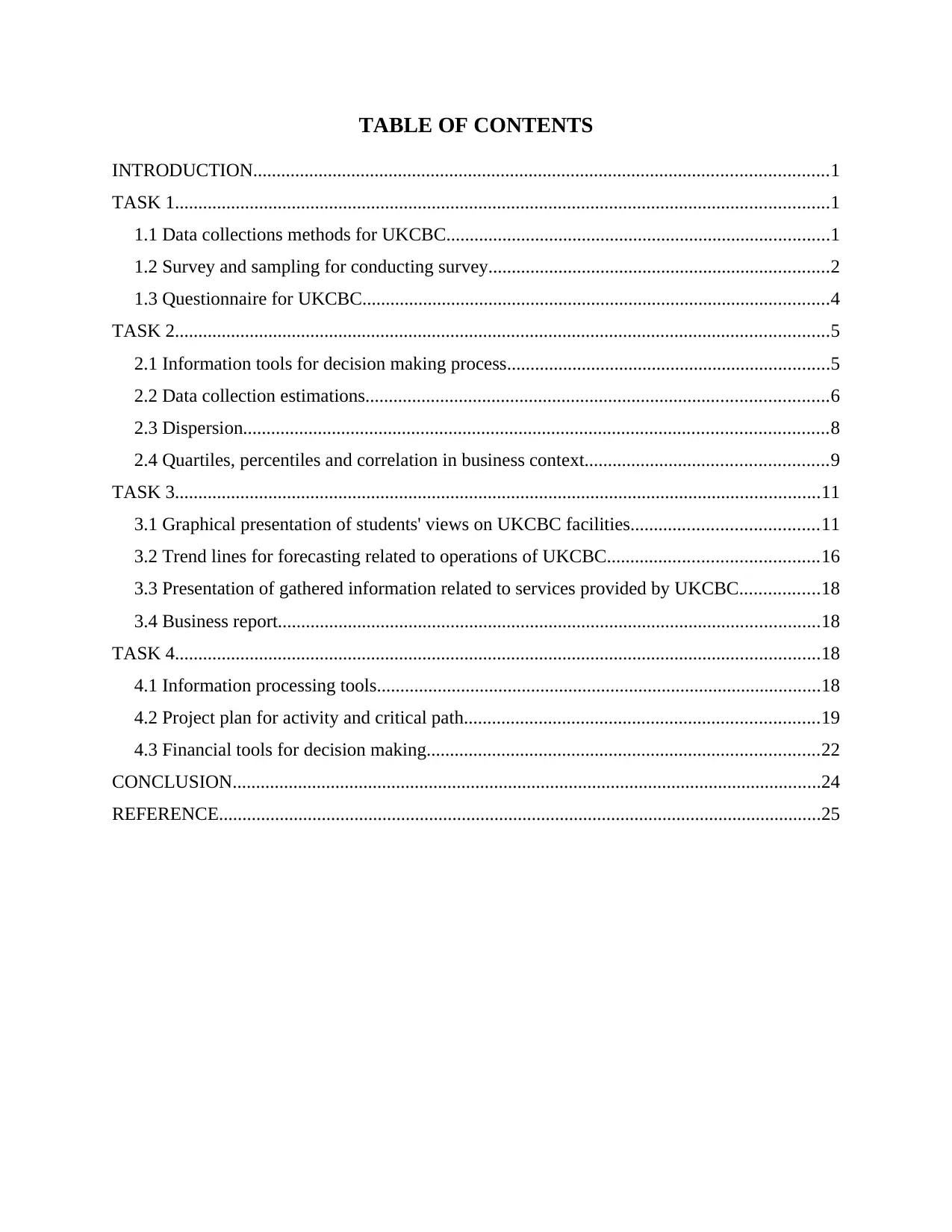
TABLE OF CONTENTS
INTRODUCTION...........................................................................................................................1
TASK 1............................................................................................................................................1
1.1 Data collections methods for UKCBC..................................................................................1
1.2 Survey and sampling for conducting survey.........................................................................2
1.3 Questionnaire for UKCBC....................................................................................................4
TASK 2............................................................................................................................................5
2.1 Information tools for decision making process.....................................................................5
2.2 Data collection estimations...................................................................................................6
2.3 Dispersion.............................................................................................................................8
2.4 Quartiles, percentiles and correlation in business context....................................................9
TASK 3..........................................................................................................................................11
3.1 Graphical presentation of students' views on UKCBC facilities........................................11
3.2 Trend lines for forecasting related to operations of UKCBC.............................................16
3.3 Presentation of gathered information related to services provided by UKCBC.................18
3.4 Business report....................................................................................................................18
TASK 4..........................................................................................................................................18
4.1 Information processing tools...............................................................................................18
4.2 Project plan for activity and critical path............................................................................19
4.3 Financial tools for decision making....................................................................................22
CONCLUSION..............................................................................................................................24
REFERENCE.................................................................................................................................25
INTRODUCTION...........................................................................................................................1
TASK 1............................................................................................................................................1
1.1 Data collections methods for UKCBC..................................................................................1
1.2 Survey and sampling for conducting survey.........................................................................2
1.3 Questionnaire for UKCBC....................................................................................................4
TASK 2............................................................................................................................................5
2.1 Information tools for decision making process.....................................................................5
2.2 Data collection estimations...................................................................................................6
2.3 Dispersion.............................................................................................................................8
2.4 Quartiles, percentiles and correlation in business context....................................................9
TASK 3..........................................................................................................................................11
3.1 Graphical presentation of students' views on UKCBC facilities........................................11
3.2 Trend lines for forecasting related to operations of UKCBC.............................................16
3.3 Presentation of gathered information related to services provided by UKCBC.................18
3.4 Business report....................................................................................................................18
TASK 4..........................................................................................................................................18
4.1 Information processing tools...............................................................................................18
4.2 Project plan for activity and critical path............................................................................19
4.3 Financial tools for decision making....................................................................................22
CONCLUSION..............................................................................................................................24
REFERENCE.................................................................................................................................25

INDEX OF TABLES
Table 1: NPV for investment planning..........................................................................................22
Table 2: IRR...................................................................................................................................23
Table 3: ARR for investment planning..........................................................................................24
Table 1: NPV for investment planning..........................................................................................22
Table 2: IRR...................................................................................................................................23
Table 3: ARR for investment planning..........................................................................................24
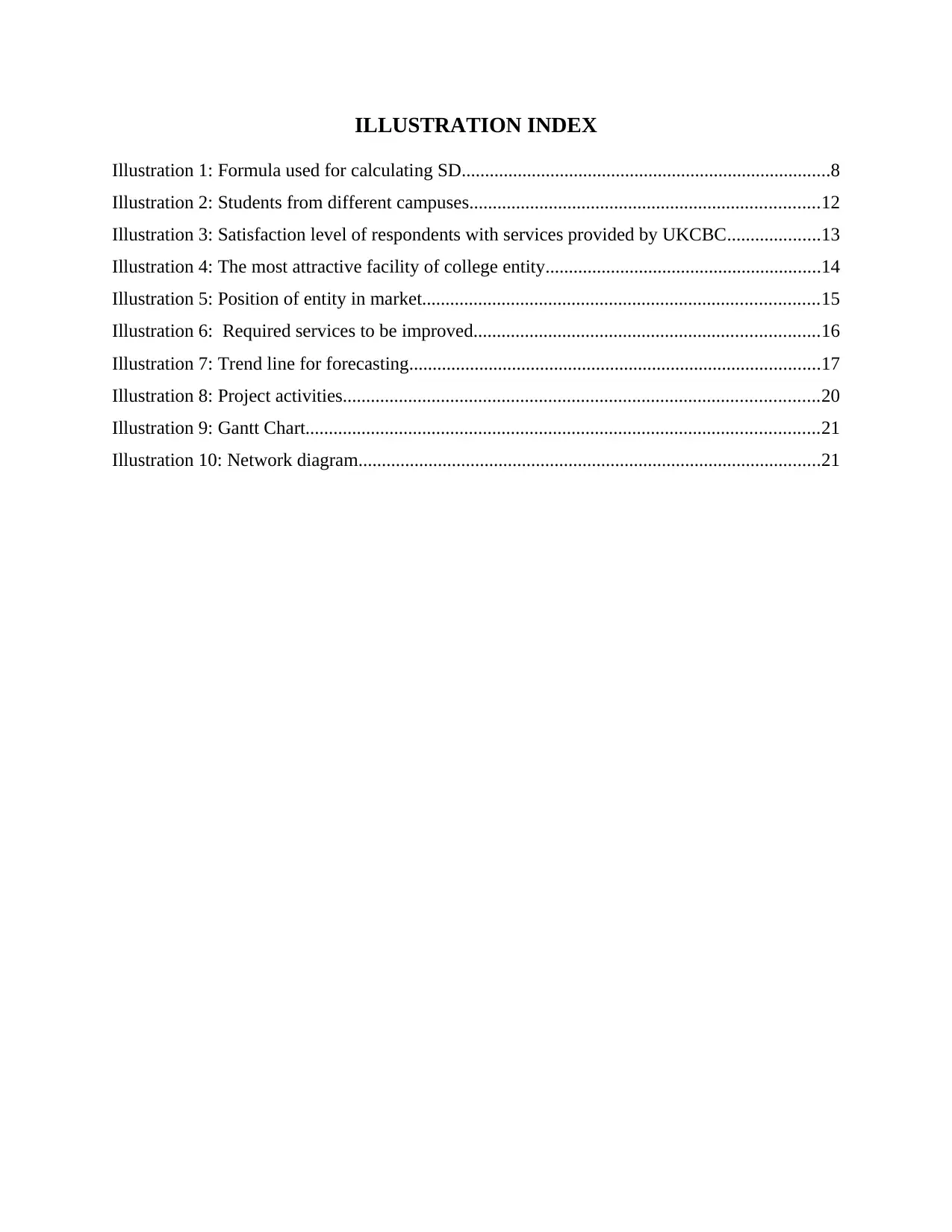
ILLUSTRATION INDEX
Illustration 1: Formula used for calculating SD...............................................................................8
Illustration 2: Students from different campuses...........................................................................12
Illustration 3: Satisfaction level of respondents with services provided by UKCBC....................13
Illustration 4: The most attractive facility of college entity...........................................................14
Illustration 5: Position of entity in market.....................................................................................15
Illustration 6: Required services to be improved..........................................................................16
Illustration 7: Trend line for forecasting........................................................................................17
Illustration 8: Project activities......................................................................................................20
Illustration 9: Gantt Chart..............................................................................................................21
Illustration 10: Network diagram...................................................................................................21
Illustration 1: Formula used for calculating SD...............................................................................8
Illustration 2: Students from different campuses...........................................................................12
Illustration 3: Satisfaction level of respondents with services provided by UKCBC....................13
Illustration 4: The most attractive facility of college entity...........................................................14
Illustration 5: Position of entity in market.....................................................................................15
Illustration 6: Required services to be improved..........................................................................16
Illustration 7: Trend line for forecasting........................................................................................17
Illustration 8: Project activities......................................................................................................20
Illustration 9: Gantt Chart..............................................................................................................21
Illustration 10: Network diagram...................................................................................................21
Secure Best Marks with AI Grader
Need help grading? Try our AI Grader for instant feedback on your assignments.
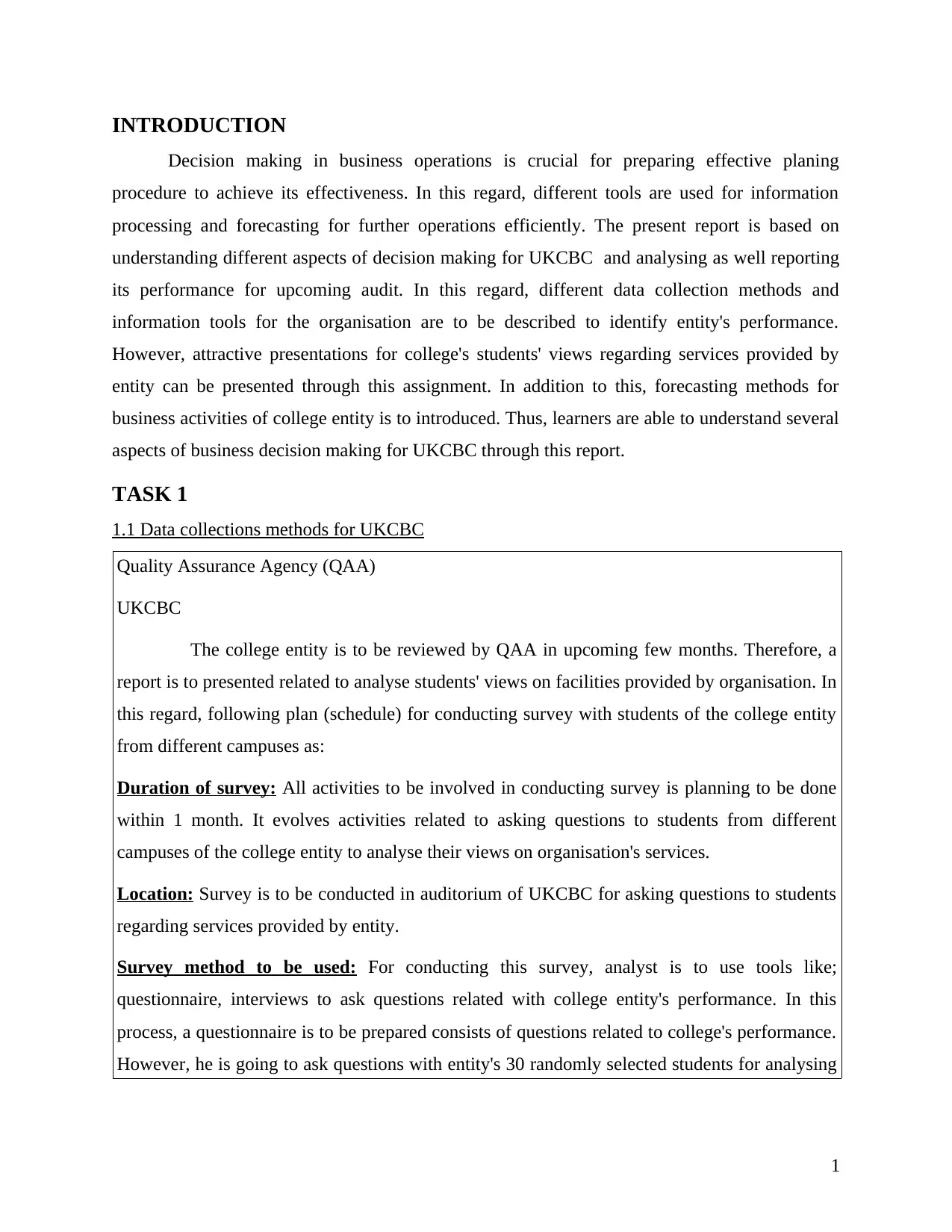
INTRODUCTION
Decision making in business operations is crucial for preparing effective planing
procedure to achieve its effectiveness. In this regard, different tools are used for information
processing and forecasting for further operations efficiently. The present report is based on
understanding different aspects of decision making for UKCBC and analysing as well reporting
its performance for upcoming audit. In this regard, different data collection methods and
information tools for the organisation are to be described to identify entity's performance.
However, attractive presentations for college's students' views regarding services provided by
entity can be presented through this assignment. In addition to this, forecasting methods for
business activities of college entity is to introduced. Thus, learners are able to understand several
aspects of business decision making for UKCBC through this report.
TASK 1
1.1 Data collections methods for UKCBC
Quality Assurance Agency (QAA)
UKCBC
The college entity is to be reviewed by QAA in upcoming few months. Therefore, a
report is to presented related to analyse students' views on facilities provided by organisation. In
this regard, following plan (schedule) for conducting survey with students of the college entity
from different campuses as:
Duration of survey: All activities to be involved in conducting survey is planning to be done
within 1 month. It evolves activities related to asking questions to students from different
campuses of the college entity to analyse their views on organisation's services.
Location: Survey is to be conducted in auditorium of UKCBC for asking questions to students
regarding services provided by entity.
Survey method to be used: For conducting this survey, analyst is to use tools like;
questionnaire, interviews to ask questions related with college entity's performance. In this
process, a questionnaire is to be prepared consists of questions related to college's performance.
However, he is going to ask questions with entity's 30 randomly selected students for analysing
1
Decision making in business operations is crucial for preparing effective planing
procedure to achieve its effectiveness. In this regard, different tools are used for information
processing and forecasting for further operations efficiently. The present report is based on
understanding different aspects of decision making for UKCBC and analysing as well reporting
its performance for upcoming audit. In this regard, different data collection methods and
information tools for the organisation are to be described to identify entity's performance.
However, attractive presentations for college's students' views regarding services provided by
entity can be presented through this assignment. In addition to this, forecasting methods for
business activities of college entity is to introduced. Thus, learners are able to understand several
aspects of business decision making for UKCBC through this report.
TASK 1
1.1 Data collections methods for UKCBC
Quality Assurance Agency (QAA)
UKCBC
The college entity is to be reviewed by QAA in upcoming few months. Therefore, a
report is to presented related to analyse students' views on facilities provided by organisation. In
this regard, following plan (schedule) for conducting survey with students of the college entity
from different campuses as:
Duration of survey: All activities to be involved in conducting survey is planning to be done
within 1 month. It evolves activities related to asking questions to students from different
campuses of the college entity to analyse their views on organisation's services.
Location: Survey is to be conducted in auditorium of UKCBC for asking questions to students
regarding services provided by entity.
Survey method to be used: For conducting this survey, analyst is to use tools like;
questionnaire, interviews to ask questions related with college entity's performance. In this
process, a questionnaire is to be prepared consists of questions related to college's performance.
However, he is going to ask questions with entity's 30 randomly selected students for analysing
1
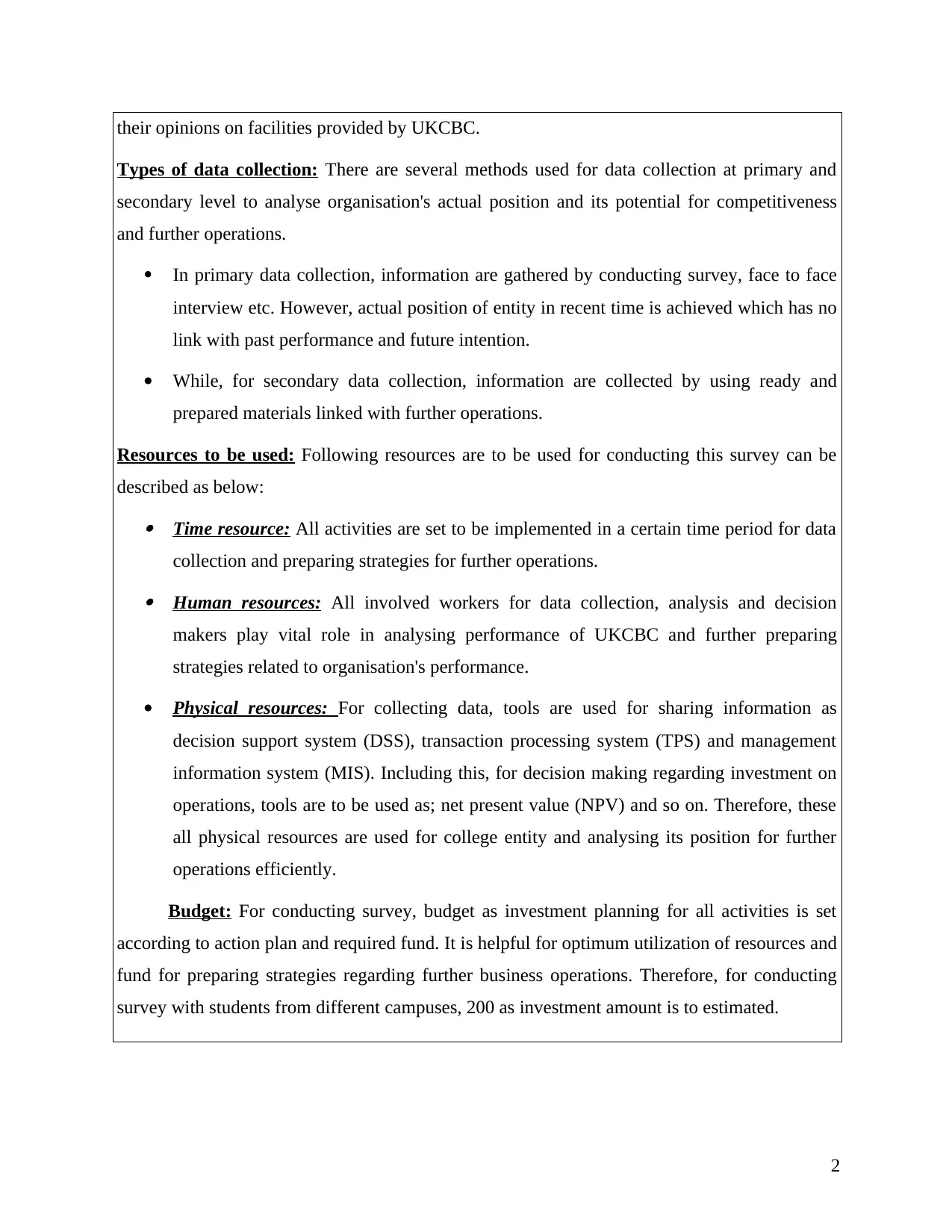
their opinions on facilities provided by UKCBC.
Types of data collection: There are several methods used for data collection at primary and
secondary level to analyse organisation's actual position and its potential for competitiveness
and further operations.
In primary data collection, information are gathered by conducting survey, face to face
interview etc. However, actual position of entity in recent time is achieved which has no
link with past performance and future intention.
While, for secondary data collection, information are collected by using ready and
prepared materials linked with further operations.
Resources to be used: Following resources are to be used for conducting this survey can be
described as below: Time resource: All activities are set to be implemented in a certain time period for data
collection and preparing strategies for further operations. Human resources: All involved workers for data collection, analysis and decision
makers play vital role in analysing performance of UKCBC and further preparing
strategies related to organisation's performance.
Physical resources: For collecting data, tools are used for sharing information as
decision support system (DSS), transaction processing system (TPS) and management
information system (MIS). Including this, for decision making regarding investment on
operations, tools are to be used as; net present value (NPV) and so on. Therefore, these
all physical resources are used for college entity and analysing its position for further
operations efficiently.
Budget: For conducting survey, budget as investment planning for all activities is set
according to action plan and required fund. It is helpful for optimum utilization of resources and
fund for preparing strategies regarding further business operations. Therefore, for conducting
survey with students from different campuses, 200 as investment amount is to estimated.
2
Types of data collection: There are several methods used for data collection at primary and
secondary level to analyse organisation's actual position and its potential for competitiveness
and further operations.
In primary data collection, information are gathered by conducting survey, face to face
interview etc. However, actual position of entity in recent time is achieved which has no
link with past performance and future intention.
While, for secondary data collection, information are collected by using ready and
prepared materials linked with further operations.
Resources to be used: Following resources are to be used for conducting this survey can be
described as below: Time resource: All activities are set to be implemented in a certain time period for data
collection and preparing strategies for further operations. Human resources: All involved workers for data collection, analysis and decision
makers play vital role in analysing performance of UKCBC and further preparing
strategies related to organisation's performance.
Physical resources: For collecting data, tools are used for sharing information as
decision support system (DSS), transaction processing system (TPS) and management
information system (MIS). Including this, for decision making regarding investment on
operations, tools are to be used as; net present value (NPV) and so on. Therefore, these
all physical resources are used for college entity and analysing its position for further
operations efficiently.
Budget: For conducting survey, budget as investment planning for all activities is set
according to action plan and required fund. It is helpful for optimum utilization of resources and
fund for preparing strategies regarding further business operations. Therefore, for conducting
survey with students from different campuses, 200 as investment amount is to estimated.
2
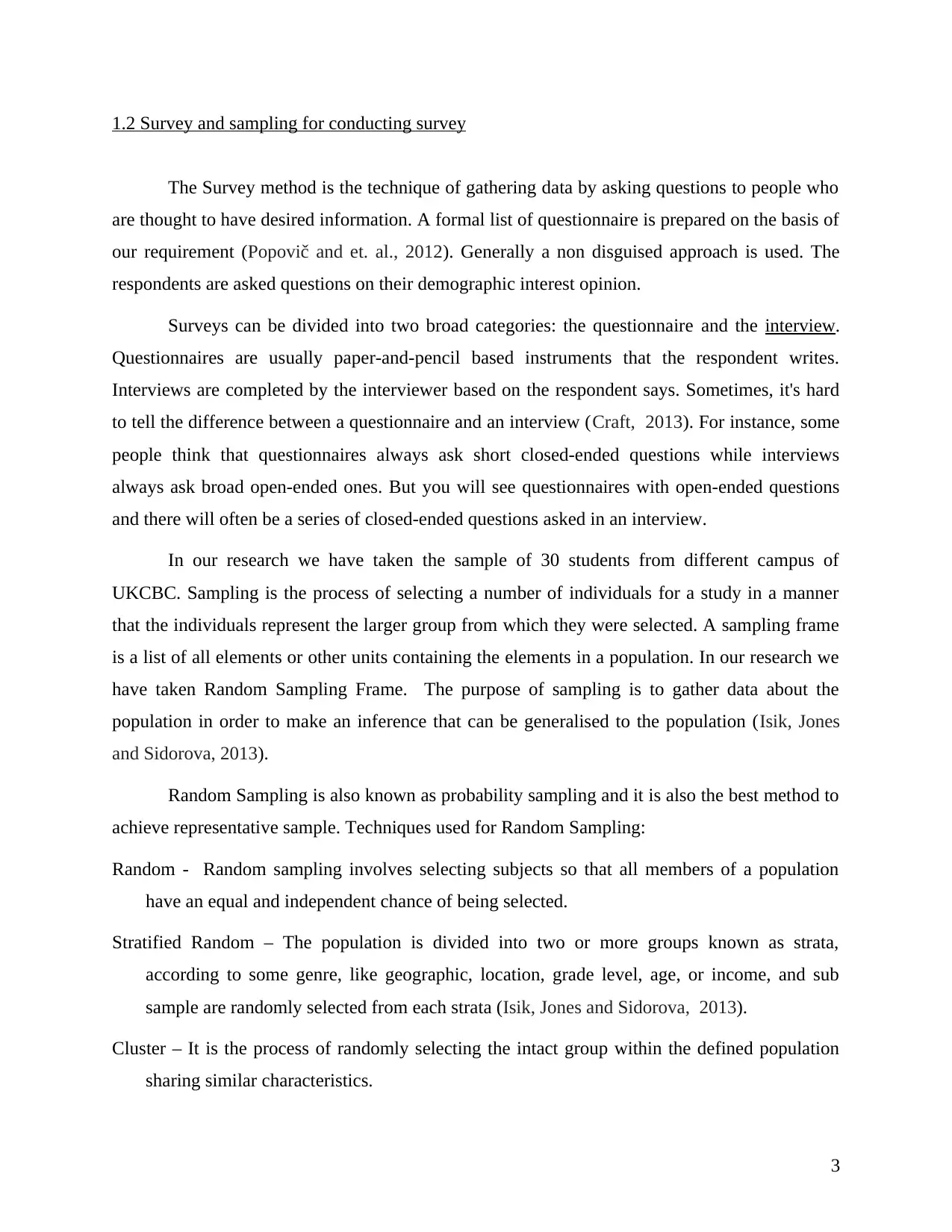
1.2 Survey and sampling for conducting survey
The Survey method is the technique of gathering data by asking questions to people who
are thought to have desired information. A formal list of questionnaire is prepared on the basis of
our requirement (Popovič and et. al., 2012). Generally a non disguised approach is used. The
respondents are asked questions on their demographic interest opinion.
Surveys can be divided into two broad categories: the questionnaire and the interview.
Questionnaires are usually paper-and-pencil based instruments that the respondent writes.
Interviews are completed by the interviewer based on the respondent says. Sometimes, it's hard
to tell the difference between a questionnaire and an interview (Craft, 2013). For instance, some
people think that questionnaires always ask short closed-ended questions while interviews
always ask broad open-ended ones. But you will see questionnaires with open-ended questions
and there will often be a series of closed-ended questions asked in an interview.
In our research we have taken the sample of 30 students from different campus of
UKCBC. Sampling is the process of selecting a number of individuals for a study in a manner
that the individuals represent the larger group from which they were selected. A sampling frame
is a list of all elements or other units containing the elements in a population. In our research we
have taken Random Sampling Frame. The purpose of sampling is to gather data about the
population in order to make an inference that can be generalised to the population (Isik, Jones
and Sidorova, 2013).
Random Sampling is also known as probability sampling and it is also the best method to
achieve representative sample. Techniques used for Random Sampling:
Random - Random sampling involves selecting subjects so that all members of a population
have an equal and independent chance of being selected.
Stratified Random – The population is divided into two or more groups known as strata,
according to some genre, like geographic, location, grade level, age, or income, and sub
sample are randomly selected from each strata (Isik, Jones and Sidorova, 2013).
Cluster – It is the process of randomly selecting the intact group within the defined population
sharing similar characteristics.
3
The Survey method is the technique of gathering data by asking questions to people who
are thought to have desired information. A formal list of questionnaire is prepared on the basis of
our requirement (Popovič and et. al., 2012). Generally a non disguised approach is used. The
respondents are asked questions on their demographic interest opinion.
Surveys can be divided into two broad categories: the questionnaire and the interview.
Questionnaires are usually paper-and-pencil based instruments that the respondent writes.
Interviews are completed by the interviewer based on the respondent says. Sometimes, it's hard
to tell the difference between a questionnaire and an interview (Craft, 2013). For instance, some
people think that questionnaires always ask short closed-ended questions while interviews
always ask broad open-ended ones. But you will see questionnaires with open-ended questions
and there will often be a series of closed-ended questions asked in an interview.
In our research we have taken the sample of 30 students from different campus of
UKCBC. Sampling is the process of selecting a number of individuals for a study in a manner
that the individuals represent the larger group from which they were selected. A sampling frame
is a list of all elements or other units containing the elements in a population. In our research we
have taken Random Sampling Frame. The purpose of sampling is to gather data about the
population in order to make an inference that can be generalised to the population (Isik, Jones
and Sidorova, 2013).
Random Sampling is also known as probability sampling and it is also the best method to
achieve representative sample. Techniques used for Random Sampling:
Random - Random sampling involves selecting subjects so that all members of a population
have an equal and independent chance of being selected.
Stratified Random – The population is divided into two or more groups known as strata,
according to some genre, like geographic, location, grade level, age, or income, and sub
sample are randomly selected from each strata (Isik, Jones and Sidorova, 2013).
Cluster – It is the process of randomly selecting the intact group within the defined population
sharing similar characteristics.
3
Paraphrase This Document
Need a fresh take? Get an instant paraphrase of this document with our AI Paraphraser
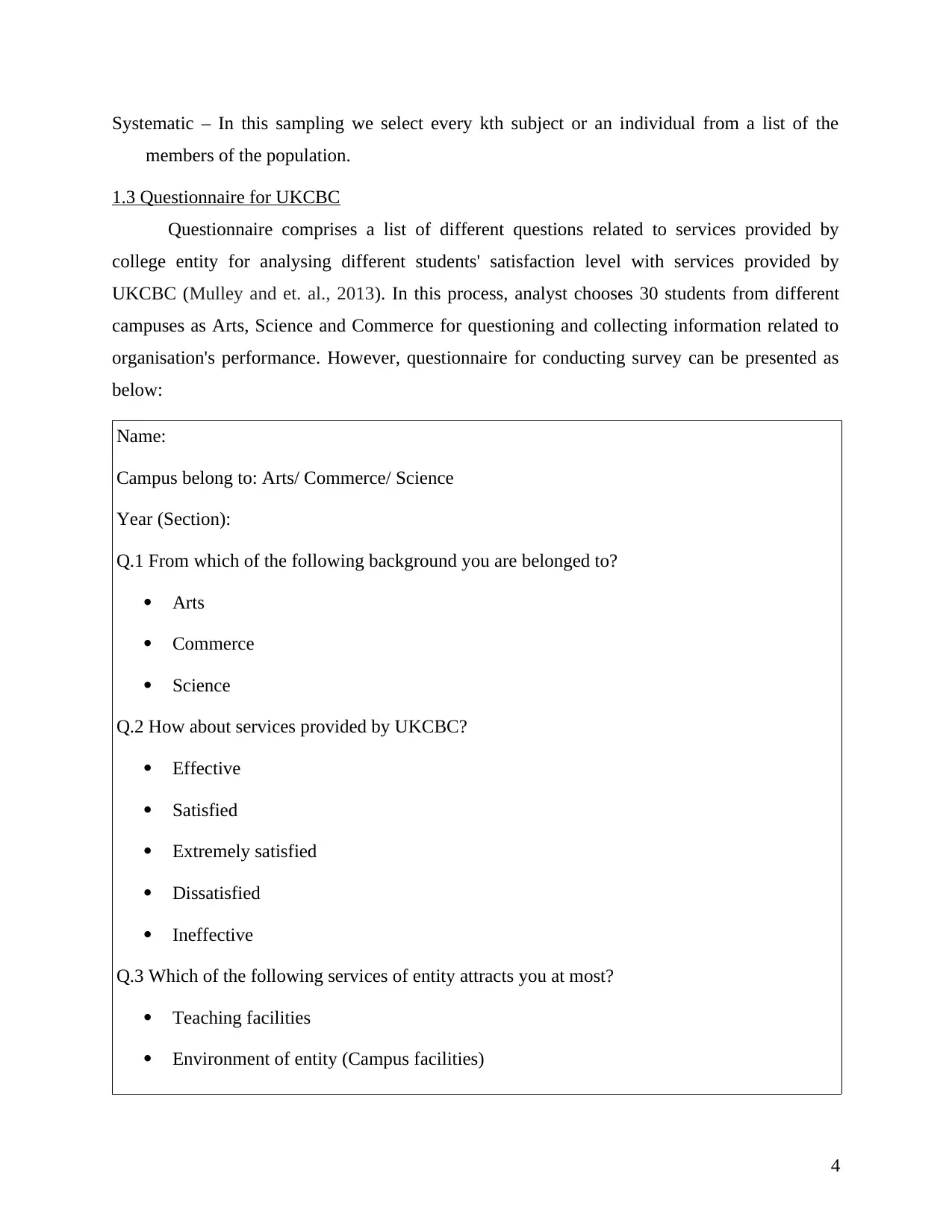
Systematic – In this sampling we select every kth subject or an individual from a list of the
members of the population.
1.3 Questionnaire for UKCBC
Questionnaire comprises a list of different questions related to services provided by
college entity for analysing different students' satisfaction level with services provided by
UKCBC (Mulley and et. al., 2013). In this process, analyst chooses 30 students from different
campuses as Arts, Science and Commerce for questioning and collecting information related to
organisation's performance. However, questionnaire for conducting survey can be presented as
below:
Name:
Campus belong to: Arts/ Commerce/ Science
Year (Section):
Q.1 From which of the following background you are belonged to?
Arts
Commerce
Science
Q.2 How about services provided by UKCBC?
Effective
Satisfied
Extremely satisfied
Dissatisfied
Ineffective
Q.3 Which of the following services of entity attracts you at most?
Teaching facilities
Environment of entity (Campus facilities)
4
members of the population.
1.3 Questionnaire for UKCBC
Questionnaire comprises a list of different questions related to services provided by
college entity for analysing different students' satisfaction level with services provided by
UKCBC (Mulley and et. al., 2013). In this process, analyst chooses 30 students from different
campuses as Arts, Science and Commerce for questioning and collecting information related to
organisation's performance. However, questionnaire for conducting survey can be presented as
below:
Name:
Campus belong to: Arts/ Commerce/ Science
Year (Section):
Q.1 From which of the following background you are belonged to?
Arts
Commerce
Science
Q.2 How about services provided by UKCBC?
Effective
Satisfied
Extremely satisfied
Dissatisfied
Ineffective
Q.3 Which of the following services of entity attracts you at most?
Teaching facilities
Environment of entity (Campus facilities)
4
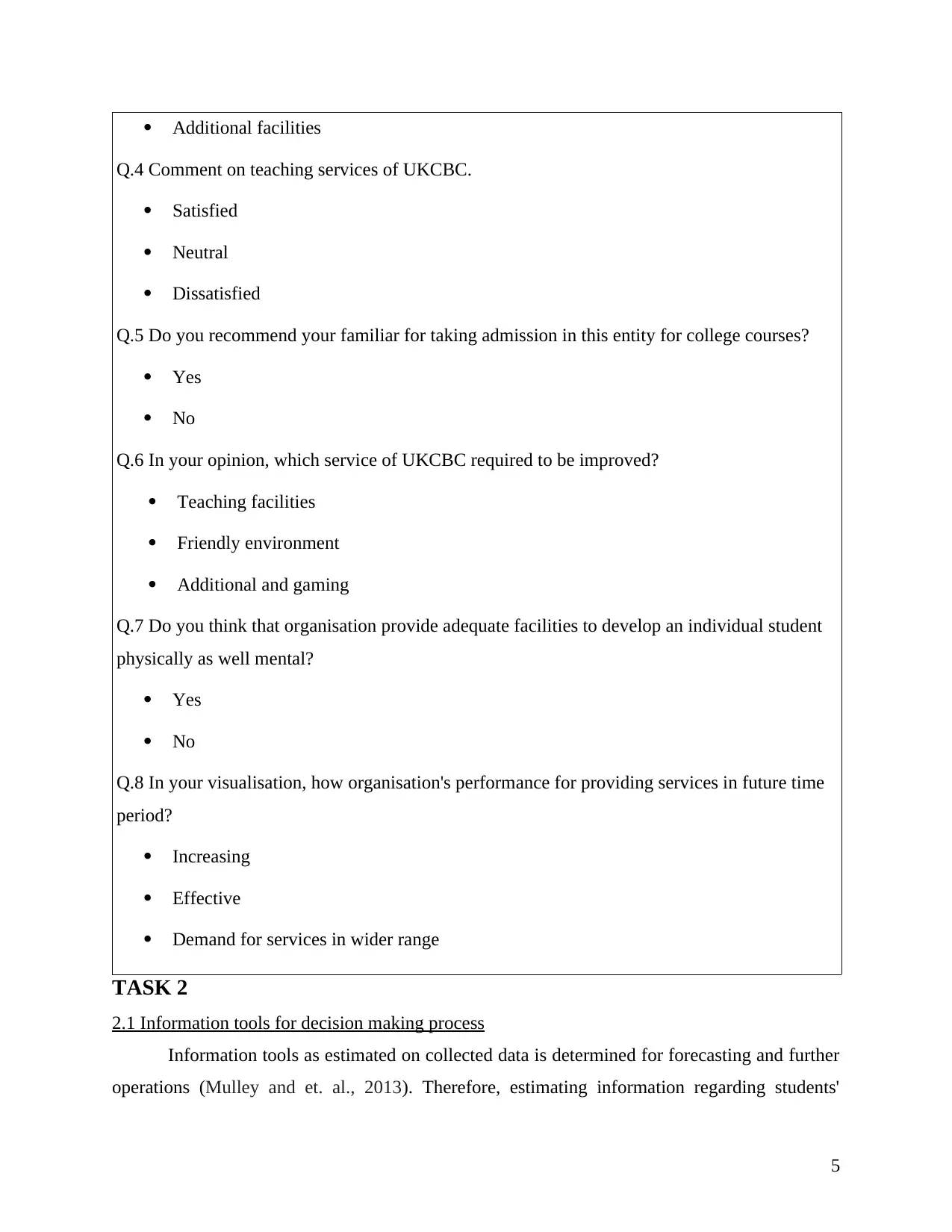
Additional facilities
Q.4 Comment on teaching services of UKCBC.
Satisfied
Neutral
Dissatisfied
Q.5 Do you recommend your familiar for taking admission in this entity for college courses?
Yes
No
Q.6 In your opinion, which service of UKCBC required to be improved?
Teaching facilities
Friendly environment
Additional and gaming
Q.7 Do you think that organisation provide adequate facilities to develop an individual student
physically as well mental?
Yes
No
Q.8 In your visualisation, how organisation's performance for providing services in future time
period?
Increasing
Effective
Demand for services in wider range
TASK 2
2.1 Information tools for decision making process
Information tools as estimated on collected data is determined for forecasting and further
operations (Mulley and et. al., 2013). Therefore, estimating information regarding students'
5
Q.4 Comment on teaching services of UKCBC.
Satisfied
Neutral
Dissatisfied
Q.5 Do you recommend your familiar for taking admission in this entity for college courses?
Yes
No
Q.6 In your opinion, which service of UKCBC required to be improved?
Teaching facilities
Friendly environment
Additional and gaming
Q.7 Do you think that organisation provide adequate facilities to develop an individual student
physically as well mental?
Yes
No
Q.8 In your visualisation, how organisation's performance for providing services in future time
period?
Increasing
Effective
Demand for services in wider range
TASK 2
2.1 Information tools for decision making process
Information tools as estimated on collected data is determined for forecasting and further
operations (Mulley and et. al., 2013). Therefore, estimating information regarding students'
5
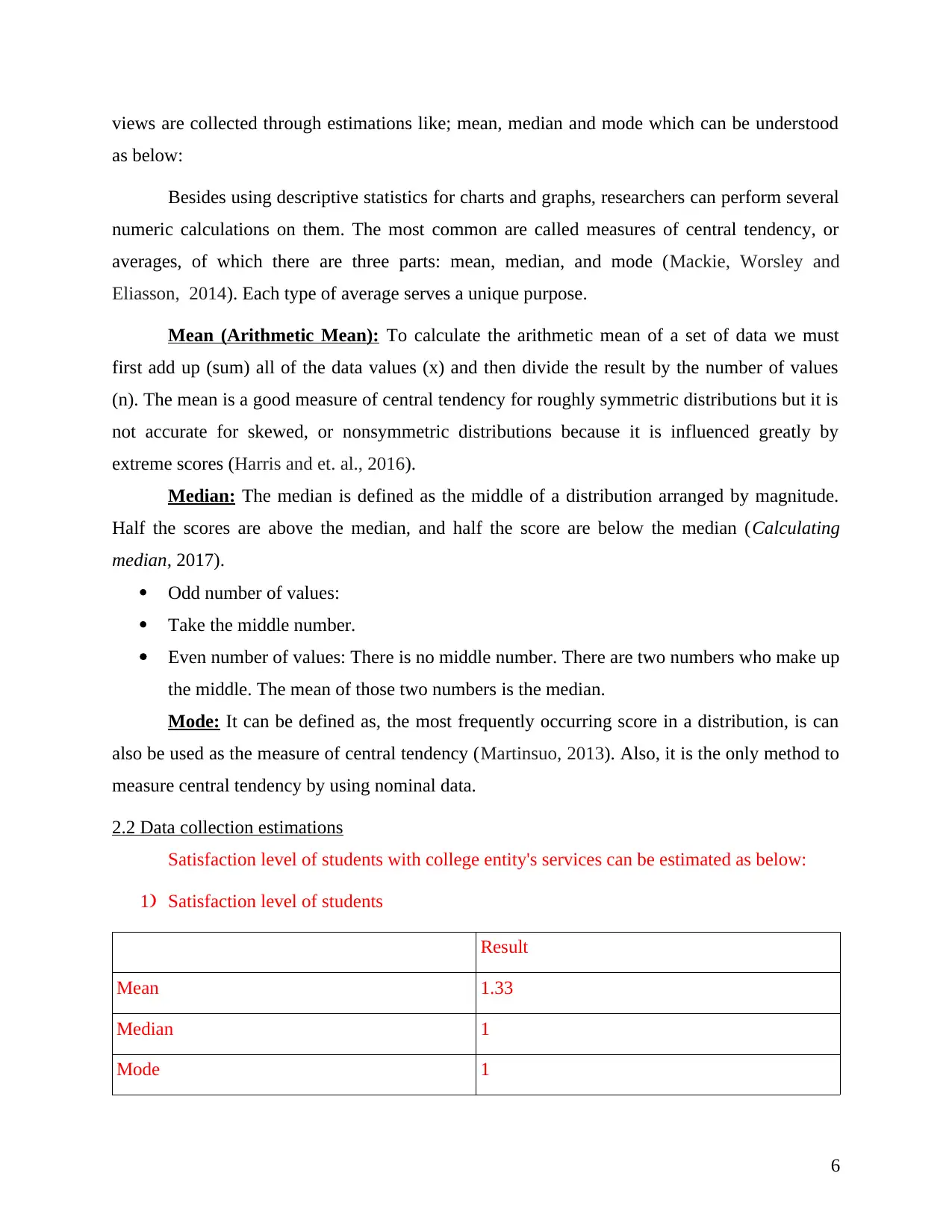
views are collected through estimations like; mean, median and mode which can be understood
as below:
Besides using descriptive statistics for charts and graphs, researchers can perform several
numeric calculations on them. The most common are called measures of central tendency, or
averages, of which there are three parts: mean, median, and mode (Mackie, Worsley and
Eliasson, 2014). Each type of average serves a unique purpose.
Mean (Arithmetic Mean): To calculate the arithmetic mean of a set of data we must
first add up (sum) all of the data values (x) and then divide the result by the number of values
(n). The mean is a good measure of central tendency for roughly symmetric distributions but it is
not accurate for skewed, or nonsymmetric distributions because it is influenced greatly by
extreme scores (Harris and et. al., 2016).
Median: The median is defined as the middle of a distribution arranged by magnitude.
Half the scores are above the median, and half the score are below the median (Calculating
median, 2017).
Odd number of values:
Take the middle number.
Even number of values: There is no middle number. There are two numbers who make up
the middle. The mean of those two numbers is the median.
Mode: It can be defined as, the most frequently occurring score in a distribution, is can
also be used as the measure of central tendency (Martinsuo, 2013). Also, it is the only method to
measure central tendency by using nominal data.
2.2 Data collection estimations
Satisfaction level of students with college entity's services can be estimated as below:
1) Satisfaction level of students
Result
Mean 1.33
Median 1
Mode 1
6
as below:
Besides using descriptive statistics for charts and graphs, researchers can perform several
numeric calculations on them. The most common are called measures of central tendency, or
averages, of which there are three parts: mean, median, and mode (Mackie, Worsley and
Eliasson, 2014). Each type of average serves a unique purpose.
Mean (Arithmetic Mean): To calculate the arithmetic mean of a set of data we must
first add up (sum) all of the data values (x) and then divide the result by the number of values
(n). The mean is a good measure of central tendency for roughly symmetric distributions but it is
not accurate for skewed, or nonsymmetric distributions because it is influenced greatly by
extreme scores (Harris and et. al., 2016).
Median: The median is defined as the middle of a distribution arranged by magnitude.
Half the scores are above the median, and half the score are below the median (Calculating
median, 2017).
Odd number of values:
Take the middle number.
Even number of values: There is no middle number. There are two numbers who make up
the middle. The mean of those two numbers is the median.
Mode: It can be defined as, the most frequently occurring score in a distribution, is can
also be used as the measure of central tendency (Martinsuo, 2013). Also, it is the only method to
measure central tendency by using nominal data.
2.2 Data collection estimations
Satisfaction level of students with college entity's services can be estimated as below:
1) Satisfaction level of students
Result
Mean 1.33
Median 1
Mode 1
6
Secure Best Marks with AI Grader
Need help grading? Try our AI Grader for instant feedback on your assignments.
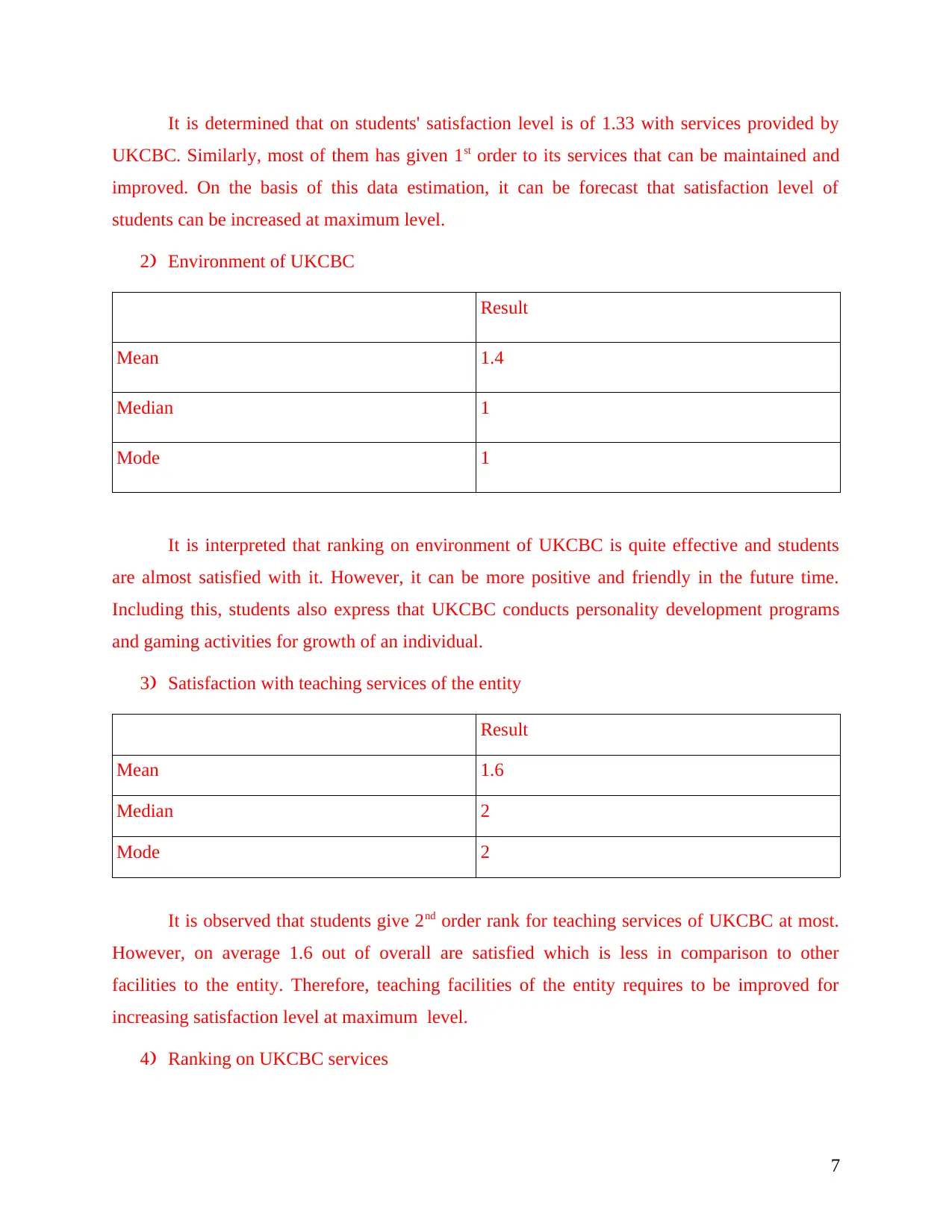
It is determined that on students' satisfaction level is of 1.33 with services provided by
UKCBC. Similarly, most of them has given 1st order to its services that can be maintained and
improved. On the basis of this data estimation, it can be forecast that satisfaction level of
students can be increased at maximum level.
2) Environment of UKCBC
Result
Mean 1.4
Median 1
Mode 1
It is interpreted that ranking on environment of UKCBC is quite effective and students
are almost satisfied with it. However, it can be more positive and friendly in the future time.
Including this, students also express that UKCBC conducts personality development programs
and gaming activities for growth of an individual.
3) Satisfaction with teaching services of the entity
Result
Mean 1.6
Median 2
Mode 2
It is observed that students give 2nd order rank for teaching services of UKCBC at most.
However, on average 1.6 out of overall are satisfied which is less in comparison to other
facilities to the entity. Therefore, teaching facilities of the entity requires to be improved for
increasing satisfaction level at maximum level.
4) Ranking on UKCBC services
7
UKCBC. Similarly, most of them has given 1st order to its services that can be maintained and
improved. On the basis of this data estimation, it can be forecast that satisfaction level of
students can be increased at maximum level.
2) Environment of UKCBC
Result
Mean 1.4
Median 1
Mode 1
It is interpreted that ranking on environment of UKCBC is quite effective and students
are almost satisfied with it. However, it can be more positive and friendly in the future time.
Including this, students also express that UKCBC conducts personality development programs
and gaming activities for growth of an individual.
3) Satisfaction with teaching services of the entity
Result
Mean 1.6
Median 2
Mode 2
It is observed that students give 2nd order rank for teaching services of UKCBC at most.
However, on average 1.6 out of overall are satisfied which is less in comparison to other
facilities to the entity. Therefore, teaching facilities of the entity requires to be improved for
increasing satisfaction level at maximum level.
4) Ranking on UKCBC services
7
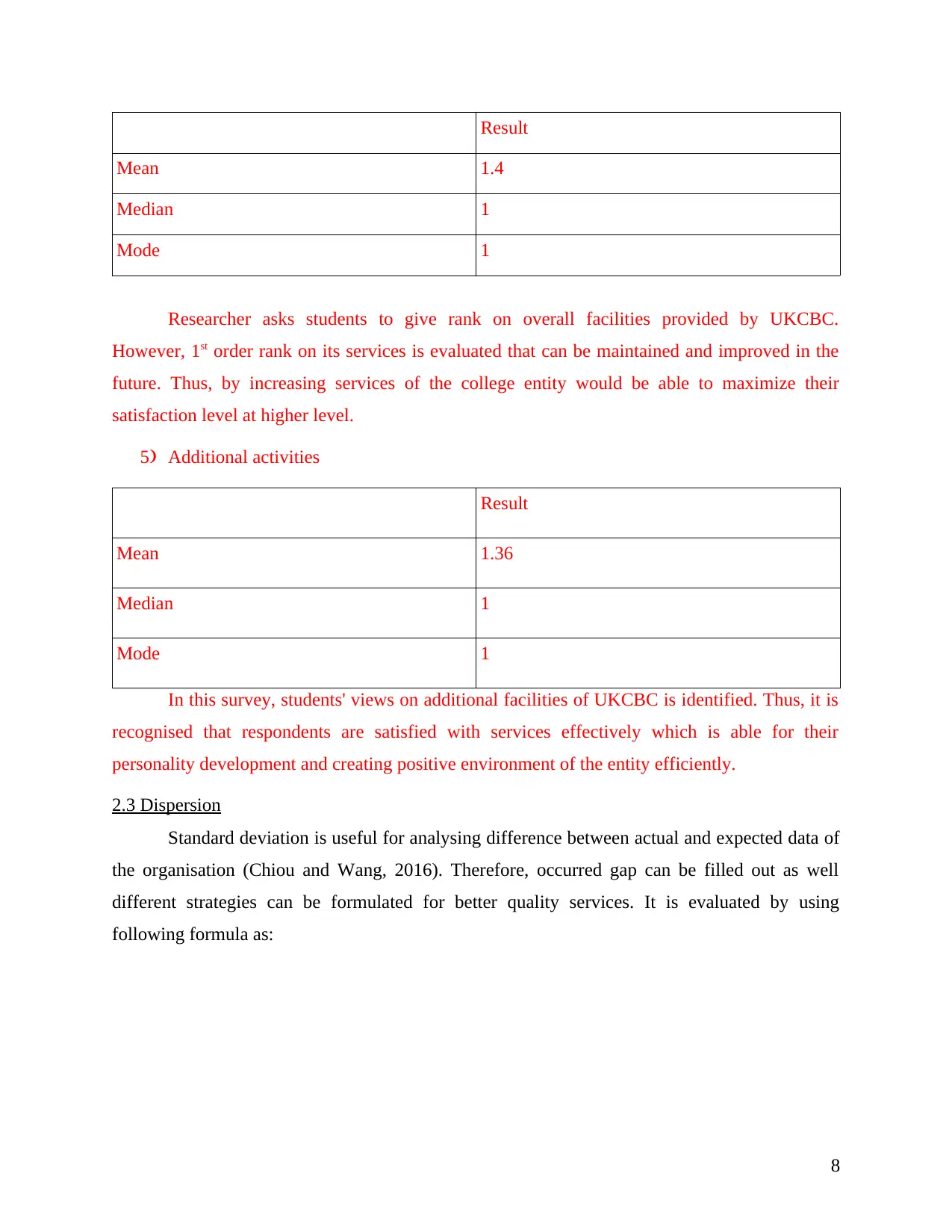
Result
Mean 1.4
Median 1
Mode 1
Researcher asks students to give rank on overall facilities provided by UKCBC.
However, 1st order rank on its services is evaluated that can be maintained and improved in the
future. Thus, by increasing services of the college entity would be able to maximize their
satisfaction level at higher level.
5) Additional activities
Result
Mean 1.36
Median 1
Mode 1
In this survey, students' views on additional facilities of UKCBC is identified. Thus, it is
recognised that respondents are satisfied with services effectively which is able for their
personality development and creating positive environment of the entity efficiently.
2.3 Dispersion
Standard deviation is useful for analysing difference between actual and expected data of
the organisation (Chiou and Wang, 2016). Therefore, occurred gap can be filled out as well
different strategies can be formulated for better quality services. It is evaluated by using
following formula as:
8
Mean 1.4
Median 1
Mode 1
Researcher asks students to give rank on overall facilities provided by UKCBC.
However, 1st order rank on its services is evaluated that can be maintained and improved in the
future. Thus, by increasing services of the college entity would be able to maximize their
satisfaction level at higher level.
5) Additional activities
Result
Mean 1.36
Median 1
Mode 1
In this survey, students' views on additional facilities of UKCBC is identified. Thus, it is
recognised that respondents are satisfied with services effectively which is able for their
personality development and creating positive environment of the entity efficiently.
2.3 Dispersion
Standard deviation is useful for analysing difference between actual and expected data of
the organisation (Chiou and Wang, 2016). Therefore, occurred gap can be filled out as well
different strategies can be formulated for better quality services. It is evaluated by using
following formula as:
8
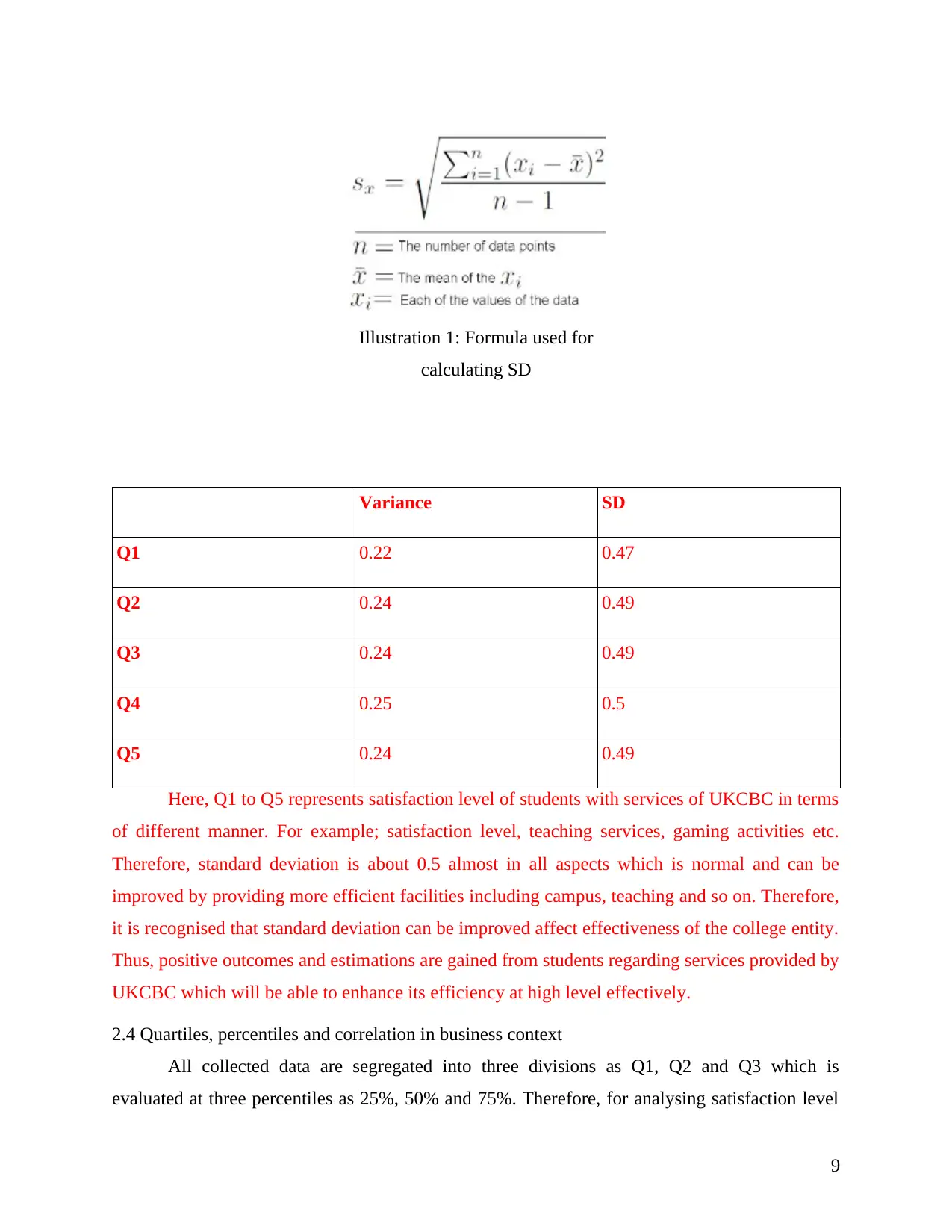
Variance SD
Q1 0.22 0.47
Q2 0.24 0.49
Q3 0.24 0.49
Q4 0.25 0.5
Q5 0.24 0.49
Here, Q1 to Q5 represents satisfaction level of students with services of UKCBC in terms
of different manner. For example; satisfaction level, teaching services, gaming activities etc.
Therefore, standard deviation is about 0.5 almost in all aspects which is normal and can be
improved by providing more efficient facilities including campus, teaching and so on. Therefore,
it is recognised that standard deviation can be improved affect effectiveness of the college entity.
Thus, positive outcomes and estimations are gained from students regarding services provided by
UKCBC which will be able to enhance its efficiency at high level effectively.
2.4 Quartiles, percentiles and correlation in business context
All collected data are segregated into three divisions as Q1, Q2 and Q3 which is
evaluated at three percentiles as 25%, 50% and 75%. Therefore, for analysing satisfaction level
9
Illustration 1: Formula used for
calculating SD
Q1 0.22 0.47
Q2 0.24 0.49
Q3 0.24 0.49
Q4 0.25 0.5
Q5 0.24 0.49
Here, Q1 to Q5 represents satisfaction level of students with services of UKCBC in terms
of different manner. For example; satisfaction level, teaching services, gaming activities etc.
Therefore, standard deviation is about 0.5 almost in all aspects which is normal and can be
improved by providing more efficient facilities including campus, teaching and so on. Therefore,
it is recognised that standard deviation can be improved affect effectiveness of the college entity.
Thus, positive outcomes and estimations are gained from students regarding services provided by
UKCBC which will be able to enhance its efficiency at high level effectively.
2.4 Quartiles, percentiles and correlation in business context
All collected data are segregated into three divisions as Q1, Q2 and Q3 which is
evaluated at three percentiles as 25%, 50% and 75%. Therefore, for analysing satisfaction level
9
Illustration 1: Formula used for
calculating SD
Paraphrase This Document
Need a fresh take? Get an instant paraphrase of this document with our AI Paraphraser
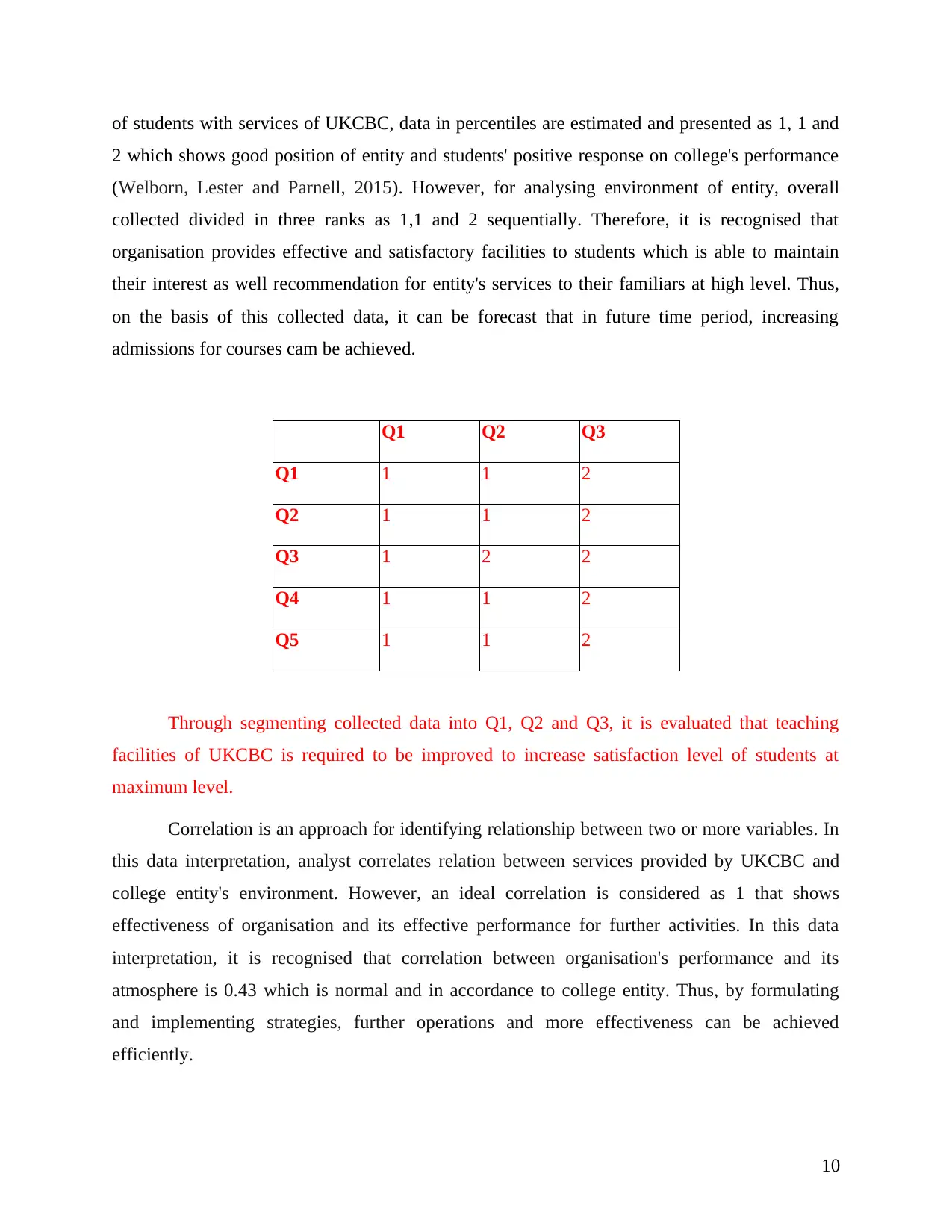
of students with services of UKCBC, data in percentiles are estimated and presented as 1, 1 and
2 which shows good position of entity and students' positive response on college's performance
(Welborn, Lester and Parnell, 2015). However, for analysing environment of entity, overall
collected divided in three ranks as 1,1 and 2 sequentially. Therefore, it is recognised that
organisation provides effective and satisfactory facilities to students which is able to maintain
their interest as well recommendation for entity's services to their familiars at high level. Thus,
on the basis of this collected data, it can be forecast that in future time period, increasing
admissions for courses cam be achieved.
Q1 Q2 Q3
Q1 1 1 2
Q2 1 1 2
Q3 1 2 2
Q4 1 1 2
Q5 1 1 2
Through segmenting collected data into Q1, Q2 and Q3, it is evaluated that teaching
facilities of UKCBC is required to be improved to increase satisfaction level of students at
maximum level.
Correlation is an approach for identifying relationship between two or more variables. In
this data interpretation, analyst correlates relation between services provided by UKCBC and
college entity's environment. However, an ideal correlation is considered as 1 that shows
effectiveness of organisation and its effective performance for further activities. In this data
interpretation, it is recognised that correlation between organisation's performance and its
atmosphere is 0.43 which is normal and in accordance to college entity. Thus, by formulating
and implementing strategies, further operations and more effectiveness can be achieved
efficiently.
10
2 which shows good position of entity and students' positive response on college's performance
(Welborn, Lester and Parnell, 2015). However, for analysing environment of entity, overall
collected divided in three ranks as 1,1 and 2 sequentially. Therefore, it is recognised that
organisation provides effective and satisfactory facilities to students which is able to maintain
their interest as well recommendation for entity's services to their familiars at high level. Thus,
on the basis of this collected data, it can be forecast that in future time period, increasing
admissions for courses cam be achieved.
Q1 Q2 Q3
Q1 1 1 2
Q2 1 1 2
Q3 1 2 2
Q4 1 1 2
Q5 1 1 2
Through segmenting collected data into Q1, Q2 and Q3, it is evaluated that teaching
facilities of UKCBC is required to be improved to increase satisfaction level of students at
maximum level.
Correlation is an approach for identifying relationship between two or more variables. In
this data interpretation, analyst correlates relation between services provided by UKCBC and
college entity's environment. However, an ideal correlation is considered as 1 that shows
effectiveness of organisation and its effective performance for further activities. In this data
interpretation, it is recognised that correlation between organisation's performance and its
atmosphere is 0.43 which is normal and in accordance to college entity. Thus, by formulating
and implementing strategies, further operations and more effectiveness can be achieved
efficiently.
10

11
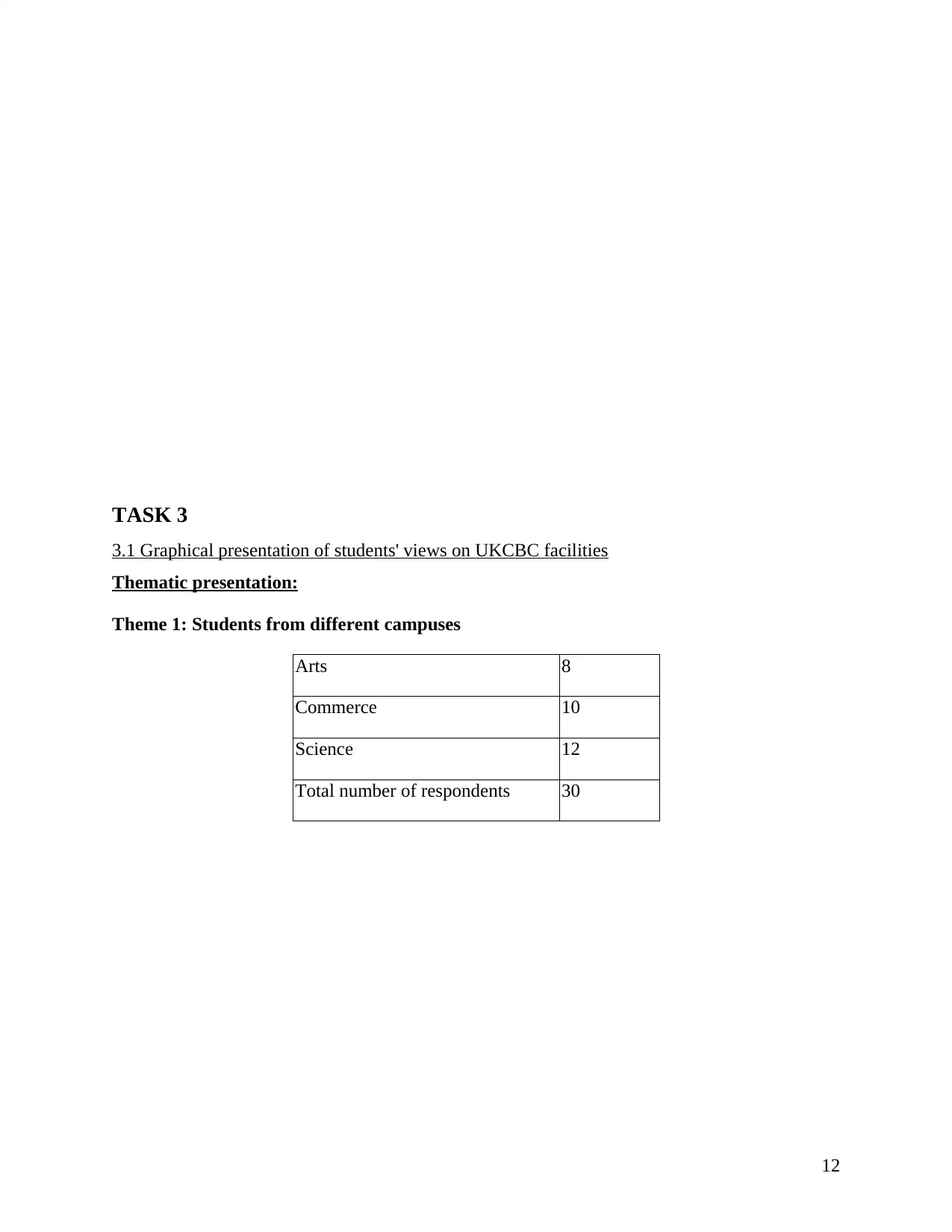
TASK 3
3.1 Graphical presentation of students' views on UKCBC facilities
Thematic presentation:
Theme 1: Students from different campuses
Arts 8
Commerce 10
Science 12
Total number of respondents 30
12
3.1 Graphical presentation of students' views on UKCBC facilities
Thematic presentation:
Theme 1: Students from different campuses
Arts 8
Commerce 10
Science 12
Total number of respondents 30
12
Secure Best Marks with AI Grader
Need help grading? Try our AI Grader for instant feedback on your assignments.
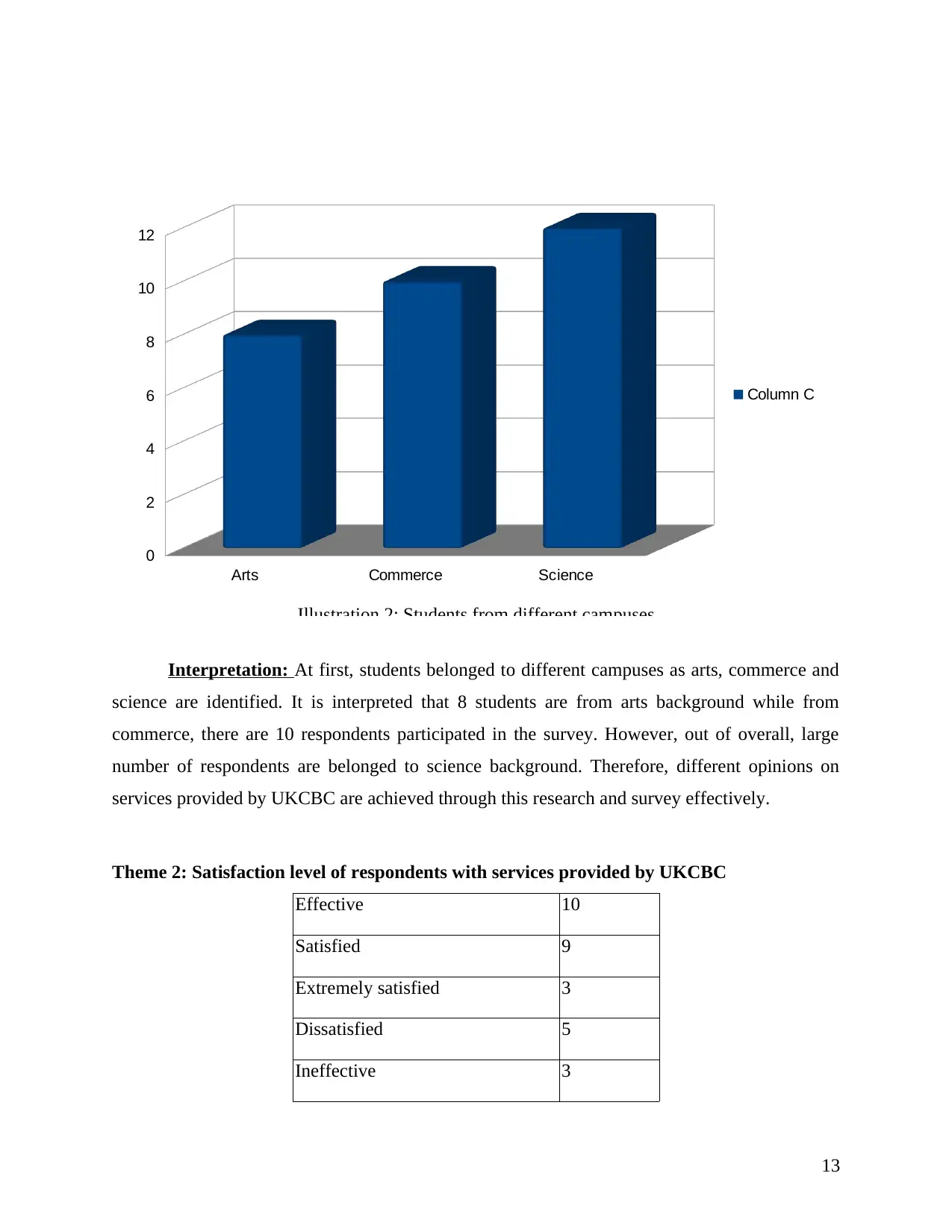
Interpretation: At first, students belonged to different campuses as arts, commerce and
science are identified. It is interpreted that 8 students are from arts background while from
commerce, there are 10 respondents participated in the survey. However, out of overall, large
number of respondents are belonged to science background. Therefore, different opinions on
services provided by UKCBC are achieved through this research and survey effectively.
Theme 2: Satisfaction level of respondents with services provided by UKCBC
Effective 10
Satisfied 9
Extremely satisfied 3
Dissatisfied 5
Ineffective 3
13
Arts Commerce Science
0
2
4
6
8
10
12
Column C
Illustration 2: Students from different campuses
science are identified. It is interpreted that 8 students are from arts background while from
commerce, there are 10 respondents participated in the survey. However, out of overall, large
number of respondents are belonged to science background. Therefore, different opinions on
services provided by UKCBC are achieved through this research and survey effectively.
Theme 2: Satisfaction level of respondents with services provided by UKCBC
Effective 10
Satisfied 9
Extremely satisfied 3
Dissatisfied 5
Ineffective 3
13
Arts Commerce Science
0
2
4
6
8
10
12
Column C
Illustration 2: Students from different campuses
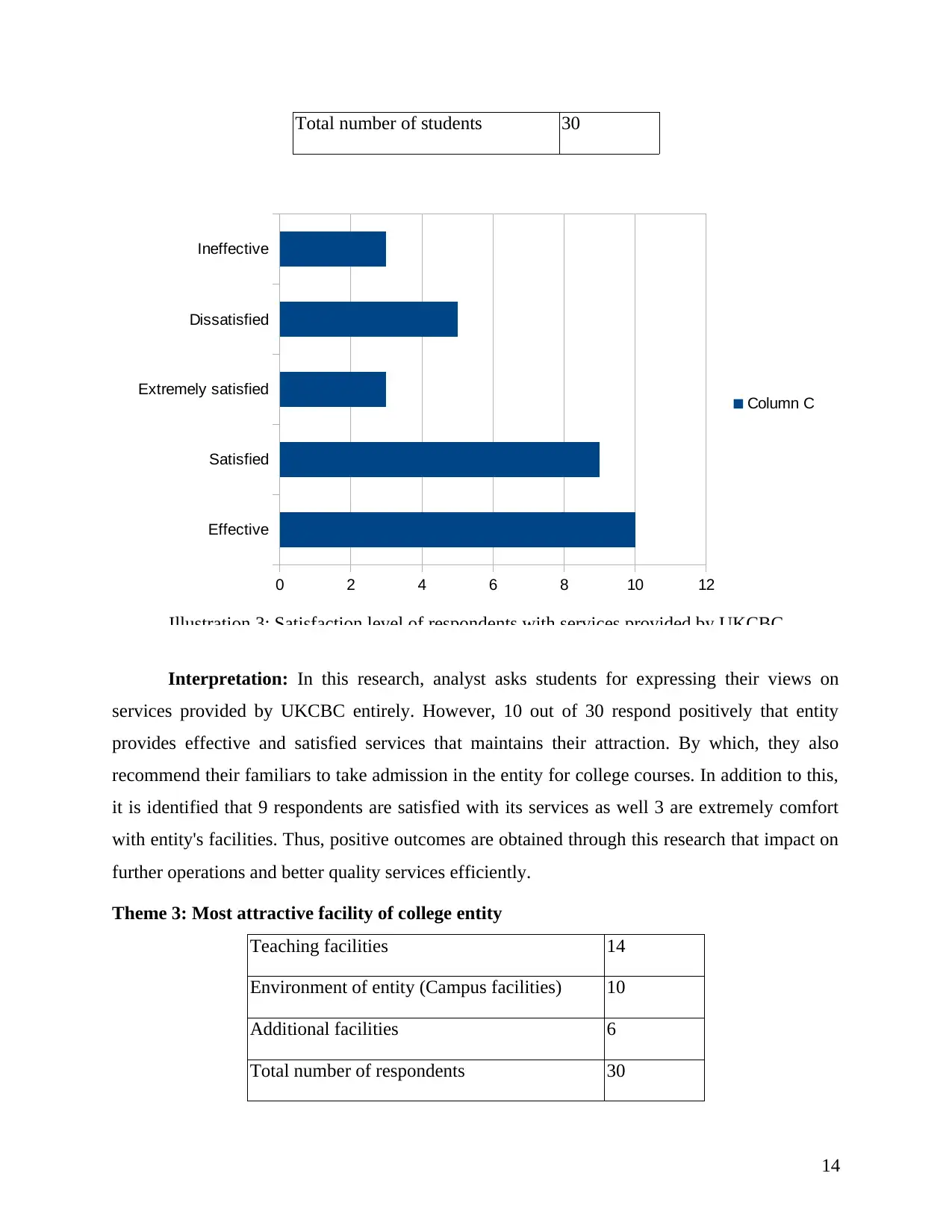
Total number of students 30
Interpretation: In this research, analyst asks students for expressing their views on
services provided by UKCBC entirely. However, 10 out of 30 respond positively that entity
provides effective and satisfied services that maintains their attraction. By which, they also
recommend their familiars to take admission in the entity for college courses. In addition to this,
it is identified that 9 respondents are satisfied with its services as well 3 are extremely comfort
with entity's facilities. Thus, positive outcomes are obtained through this research that impact on
further operations and better quality services efficiently.
Theme 3: Most attractive facility of college entity
Teaching facilities 14
Environment of entity (Campus facilities) 10
Additional facilities 6
Total number of respondents 30
14
Effective
Satisfied
Extremely satisfied
Dissatisfied
Ineffective
0 2 4 6 8 10 12
Column C
Illustration 3: Satisfaction level of respondents with services provided by UKCBC
Interpretation: In this research, analyst asks students for expressing their views on
services provided by UKCBC entirely. However, 10 out of 30 respond positively that entity
provides effective and satisfied services that maintains their attraction. By which, they also
recommend their familiars to take admission in the entity for college courses. In addition to this,
it is identified that 9 respondents are satisfied with its services as well 3 are extremely comfort
with entity's facilities. Thus, positive outcomes are obtained through this research that impact on
further operations and better quality services efficiently.
Theme 3: Most attractive facility of college entity
Teaching facilities 14
Environment of entity (Campus facilities) 10
Additional facilities 6
Total number of respondents 30
14
Effective
Satisfied
Extremely satisfied
Dissatisfied
Ineffective
0 2 4 6 8 10 12
Column C
Illustration 3: Satisfaction level of respondents with services provided by UKCBC
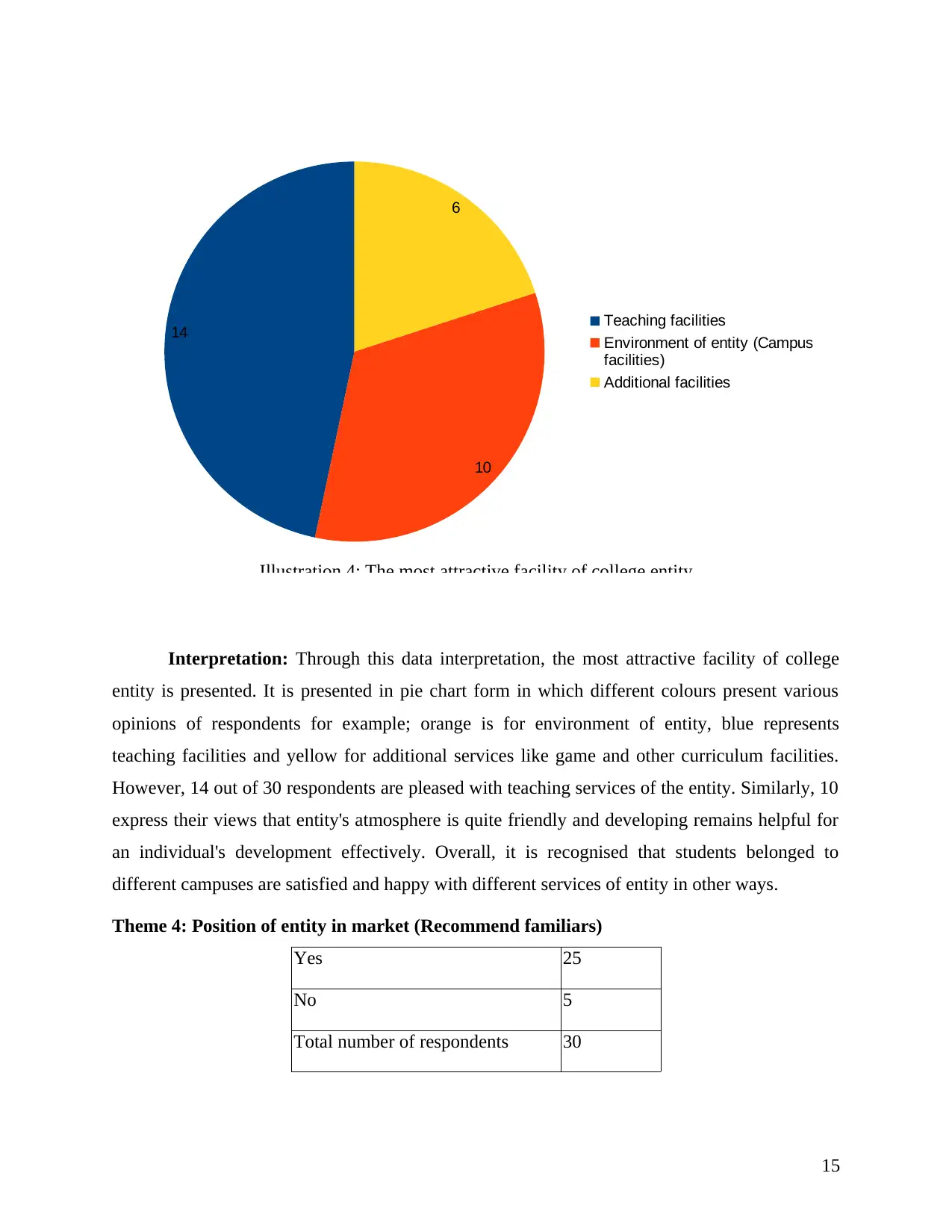
Interpretation: Through this data interpretation, the most attractive facility of college
entity is presented. It is presented in pie chart form in which different colours present various
opinions of respondents for example; orange is for environment of entity, blue represents
teaching facilities and yellow for additional services like game and other curriculum facilities.
However, 14 out of 30 respondents are pleased with teaching services of the entity. Similarly, 10
express their views that entity's atmosphere is quite friendly and developing remains helpful for
an individual's development effectively. Overall, it is recognised that students belonged to
different campuses are satisfied and happy with different services of entity in other ways.
Theme 4: Position of entity in market (Recommend familiars)
Yes 25
No 5
Total number of respondents 30
15
14
10
6
Teaching facilities
Environment of entity (Campus
facilities)
Additional facilities
Illustration 4: The most attractive facility of college entity
entity is presented. It is presented in pie chart form in which different colours present various
opinions of respondents for example; orange is for environment of entity, blue represents
teaching facilities and yellow for additional services like game and other curriculum facilities.
However, 14 out of 30 respondents are pleased with teaching services of the entity. Similarly, 10
express their views that entity's atmosphere is quite friendly and developing remains helpful for
an individual's development effectively. Overall, it is recognised that students belonged to
different campuses are satisfied and happy with different services of entity in other ways.
Theme 4: Position of entity in market (Recommend familiars)
Yes 25
No 5
Total number of respondents 30
15
14
10
6
Teaching facilities
Environment of entity (Campus
facilities)
Additional facilities
Illustration 4: The most attractive facility of college entity
Paraphrase This Document
Need a fresh take? Get an instant paraphrase of this document with our AI Paraphraser
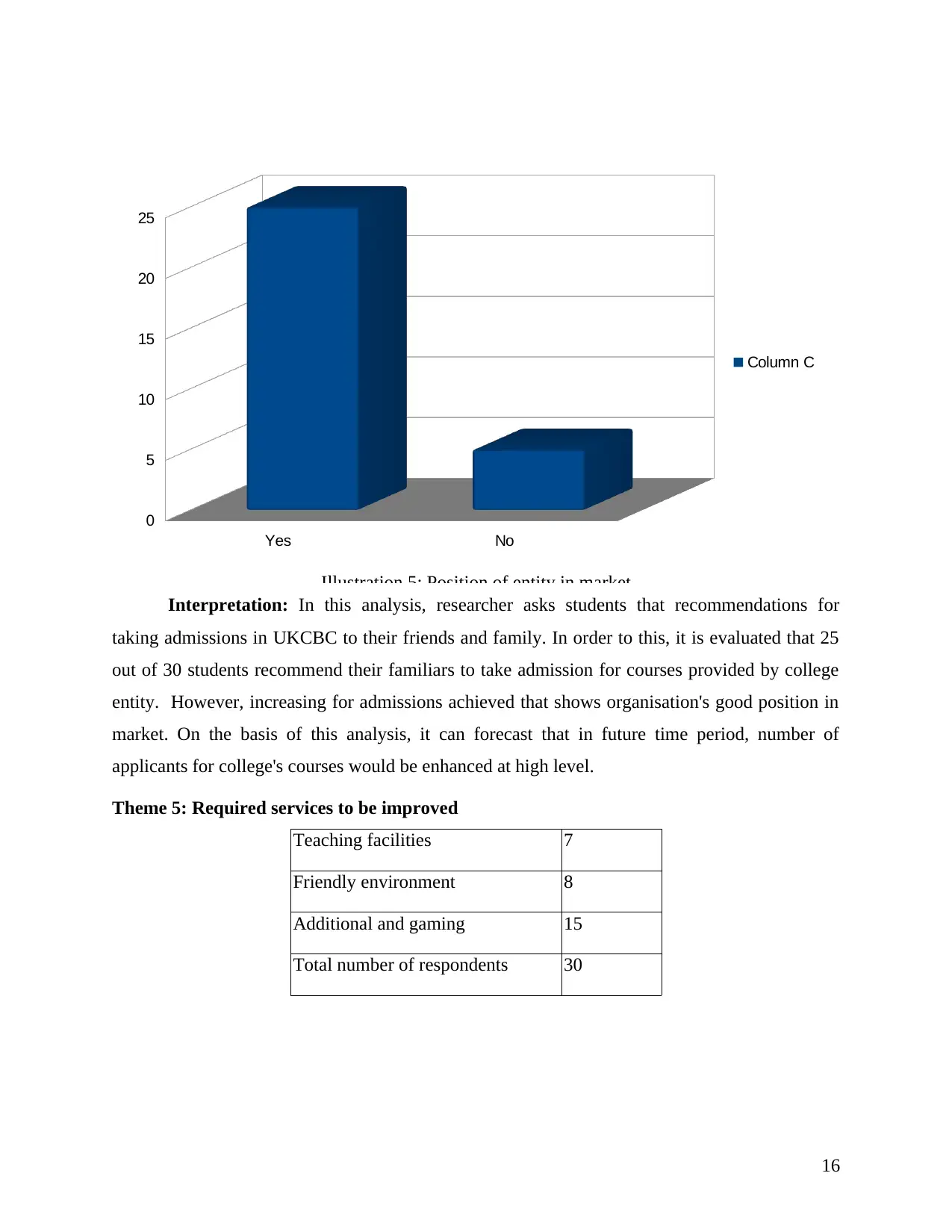
Interpretation: In this analysis, researcher asks students that recommendations for
taking admissions in UKCBC to their friends and family. In order to this, it is evaluated that 25
out of 30 students recommend their familiars to take admission for courses provided by college
entity. However, increasing for admissions achieved that shows organisation's good position in
market. On the basis of this analysis, it can forecast that in future time period, number of
applicants for college's courses would be enhanced at high level.
Theme 5: Required services to be improved
Teaching facilities 7
Friendly environment 8
Additional and gaming 15
Total number of respondents 30
16
Yes No
0
5
10
15
20
25
Column C
Illustration 5: Position of entity in market
taking admissions in UKCBC to their friends and family. In order to this, it is evaluated that 25
out of 30 students recommend their familiars to take admission for courses provided by college
entity. However, increasing for admissions achieved that shows organisation's good position in
market. On the basis of this analysis, it can forecast that in future time period, number of
applicants for college's courses would be enhanced at high level.
Theme 5: Required services to be improved
Teaching facilities 7
Friendly environment 8
Additional and gaming 15
Total number of respondents 30
16
Yes No
0
5
10
15
20
25
Column C
Illustration 5: Position of entity in market
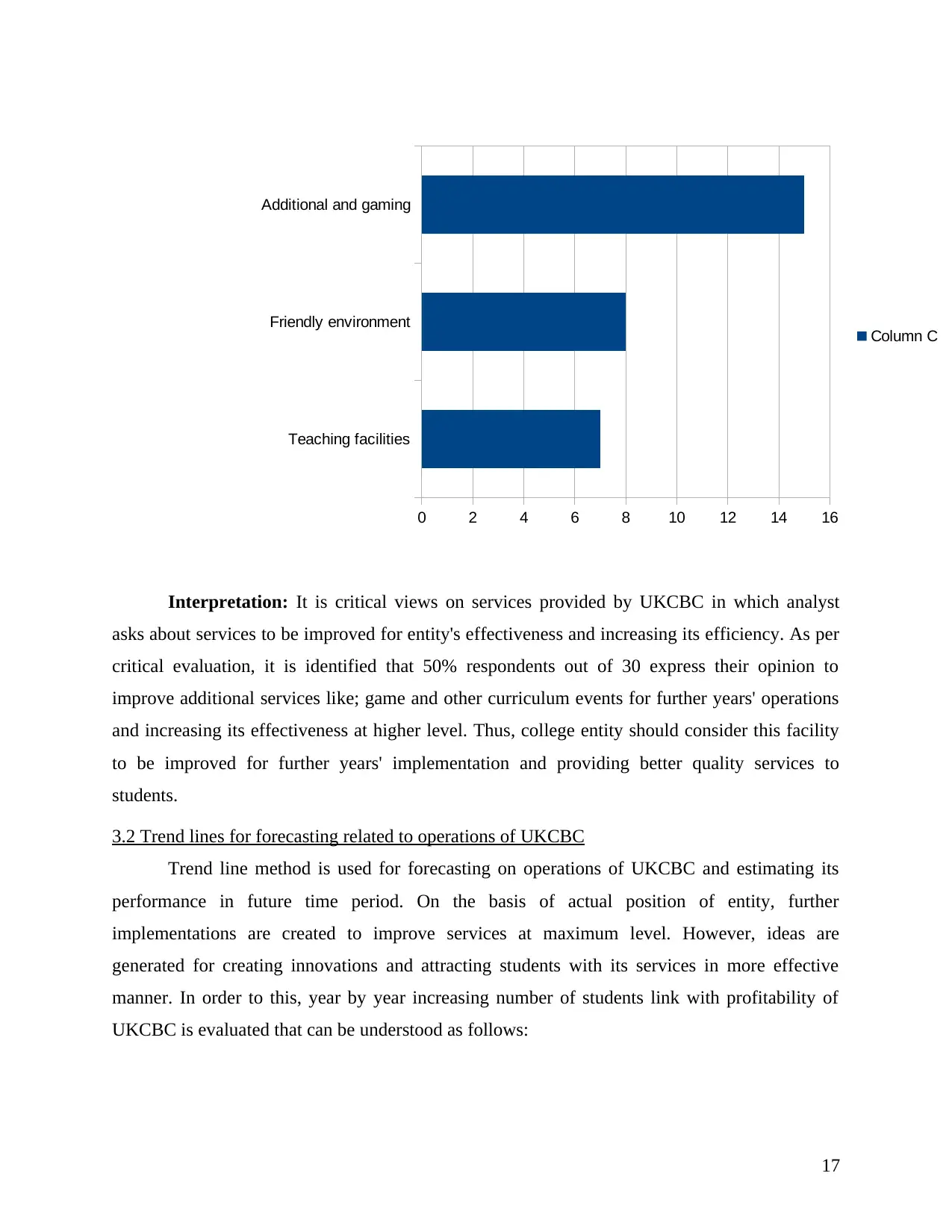
Interpretation: It is critical views on services provided by UKCBC in which analyst
asks about services to be improved for entity's effectiveness and increasing its efficiency. As per
critical evaluation, it is identified that 50% respondents out of 30 express their opinion to
improve additional services like; game and other curriculum events for further years' operations
and increasing its effectiveness at higher level. Thus, college entity should consider this facility
to be improved for further years' implementation and providing better quality services to
students.
3.2 Trend lines for forecasting related to operations of UKCBC
Trend line method is used for forecasting on operations of UKCBC and estimating its
performance in future time period. On the basis of actual position of entity, further
implementations are created to improve services at maximum level. However, ideas are
generated for creating innovations and attracting students with its services in more effective
manner. In order to this, year by year increasing number of students link with profitability of
UKCBC is evaluated that can be understood as follows:
17
Teaching facilities
Friendly environment
Additional and gaming
0 2 4 6 8 10 12 14 16
Column C
Illustration 6: Required services to be improved
asks about services to be improved for entity's effectiveness and increasing its efficiency. As per
critical evaluation, it is identified that 50% respondents out of 30 express their opinion to
improve additional services like; game and other curriculum events for further years' operations
and increasing its effectiveness at higher level. Thus, college entity should consider this facility
to be improved for further years' implementation and providing better quality services to
students.
3.2 Trend lines for forecasting related to operations of UKCBC
Trend line method is used for forecasting on operations of UKCBC and estimating its
performance in future time period. On the basis of actual position of entity, further
implementations are created to improve services at maximum level. However, ideas are
generated for creating innovations and attracting students with its services in more effective
manner. In order to this, year by year increasing number of students link with profitability of
UKCBC is evaluated that can be understood as follows:
17
Teaching facilities
Friendly environment
Additional and gaming
0 2 4 6 8 10 12 14 16
Column C
Illustration 6: Required services to be improved
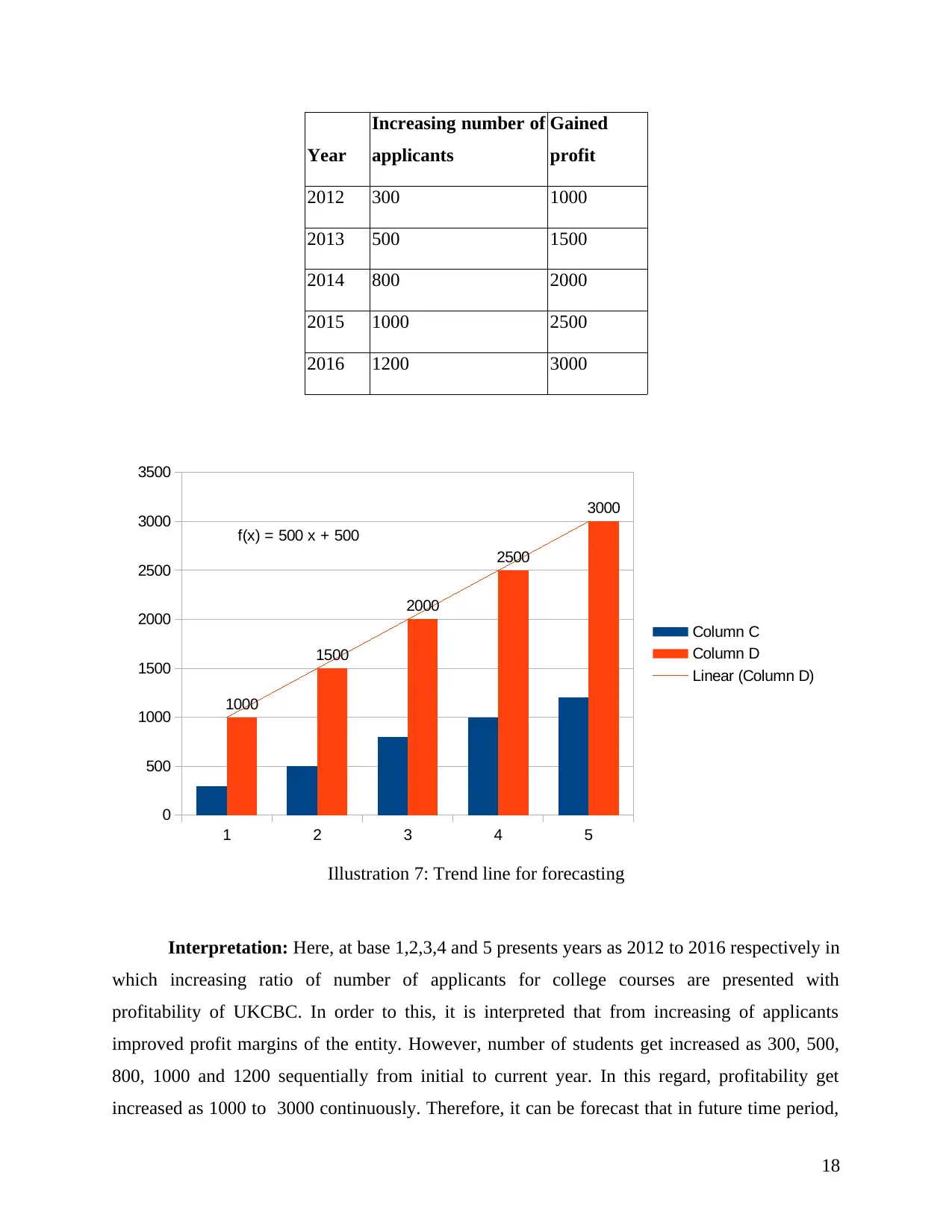
Year
Increasing number of
applicants
Gained
profit
2012 300 1000
2013 500 1500
2014 800 2000
2015 1000 2500
2016 1200 3000
Interpretation: Here, at base 1,2,3,4 and 5 presents years as 2012 to 2016 respectively in
which increasing ratio of number of applicants for college courses are presented with
profitability of UKCBC. In order to this, it is interpreted that from increasing of applicants
improved profit margins of the entity. However, number of students get increased as 300, 500,
800, 1000 and 1200 sequentially from initial to current year. In this regard, profitability get
increased as 1000 to 3000 continuously. Therefore, it can be forecast that in future time period,
18
1 2 3 4 5
0
500
1000
1500
2000
2500
3000
3500
1000
1500
2000
2500
3000
f(x) = 500 x + 500
Column C
Column D
Linear (Column D)
Illustration 7: Trend line for forecasting
Increasing number of
applicants
Gained
profit
2012 300 1000
2013 500 1500
2014 800 2000
2015 1000 2500
2016 1200 3000
Interpretation: Here, at base 1,2,3,4 and 5 presents years as 2012 to 2016 respectively in
which increasing ratio of number of applicants for college courses are presented with
profitability of UKCBC. In order to this, it is interpreted that from increasing of applicants
improved profit margins of the entity. However, number of students get increased as 300, 500,
800, 1000 and 1200 sequentially from initial to current year. In this regard, profitability get
increased as 1000 to 3000 continuously. Therefore, it can be forecast that in future time period,
18
1 2 3 4 5
0
500
1000
1500
2000
2500
3000
3500
1000
1500
2000
2500
3000
f(x) = 500 x + 500
Column C
Column D
Linear (Column D)
Illustration 7: Trend line for forecasting
Secure Best Marks with AI Grader
Need help grading? Try our AI Grader for instant feedback on your assignments.
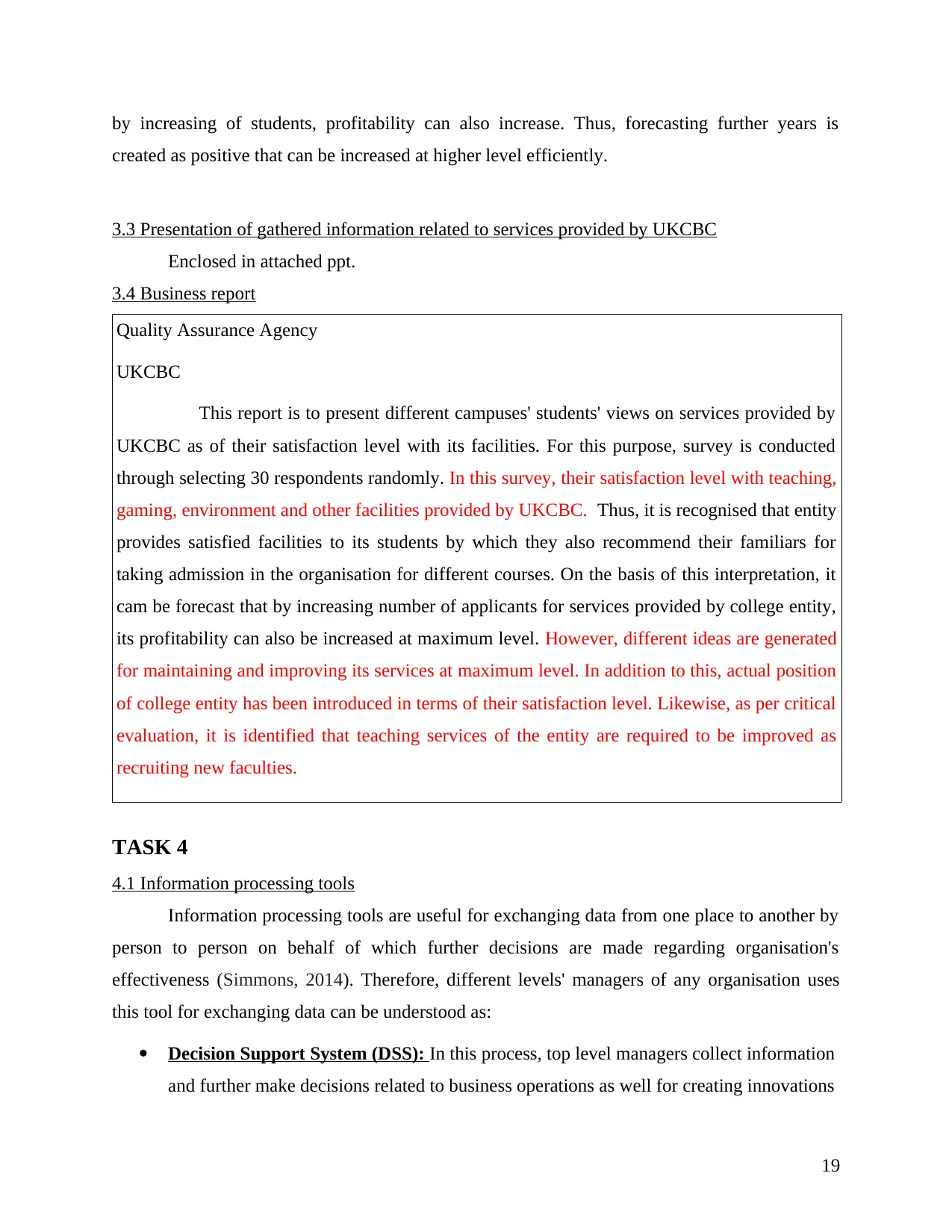
by increasing of students, profitability can also increase. Thus, forecasting further years is
created as positive that can be increased at higher level efficiently.
3.3 Presentation of gathered information related to services provided by UKCBC
Enclosed in attached ppt.
3.4 Business report
Quality Assurance Agency
UKCBC
This report is to present different campuses' students' views on services provided by
UKCBC as of their satisfaction level with its facilities. For this purpose, survey is conducted
through selecting 30 respondents randomly. In this survey, their satisfaction level with teaching,
gaming, environment and other facilities provided by UKCBC. Thus, it is recognised that entity
provides satisfied facilities to its students by which they also recommend their familiars for
taking admission in the organisation for different courses. On the basis of this interpretation, it
cam be forecast that by increasing number of applicants for services provided by college entity,
its profitability can also be increased at maximum level. However, different ideas are generated
for maintaining and improving its services at maximum level. In addition to this, actual position
of college entity has been introduced in terms of their satisfaction level. Likewise, as per critical
evaluation, it is identified that teaching services of the entity are required to be improved as
recruiting new faculties.
TASK 4
4.1 Information processing tools
Information processing tools are useful for exchanging data from one place to another by
person to person on behalf of which further decisions are made regarding organisation's
effectiveness (Simmons, 2014). Therefore, different levels' managers of any organisation uses
this tool for exchanging data can be understood as:
Decision Support System (DSS): In this process, top level managers collect information
and further make decisions related to business operations as well for creating innovations
19
created as positive that can be increased at higher level efficiently.
3.3 Presentation of gathered information related to services provided by UKCBC
Enclosed in attached ppt.
3.4 Business report
Quality Assurance Agency
UKCBC
This report is to present different campuses' students' views on services provided by
UKCBC as of their satisfaction level with its facilities. For this purpose, survey is conducted
through selecting 30 respondents randomly. In this survey, their satisfaction level with teaching,
gaming, environment and other facilities provided by UKCBC. Thus, it is recognised that entity
provides satisfied facilities to its students by which they also recommend their familiars for
taking admission in the organisation for different courses. On the basis of this interpretation, it
cam be forecast that by increasing number of applicants for services provided by college entity,
its profitability can also be increased at maximum level. However, different ideas are generated
for maintaining and improving its services at maximum level. In addition to this, actual position
of college entity has been introduced in terms of their satisfaction level. Likewise, as per critical
evaluation, it is identified that teaching services of the entity are required to be improved as
recruiting new faculties.
TASK 4
4.1 Information processing tools
Information processing tools are useful for exchanging data from one place to another by
person to person on behalf of which further decisions are made regarding organisation's
effectiveness (Simmons, 2014). Therefore, different levels' managers of any organisation uses
this tool for exchanging data can be understood as:
Decision Support System (DSS): In this process, top level managers collect information
and further make decisions related to business operations as well for creating innovations
19
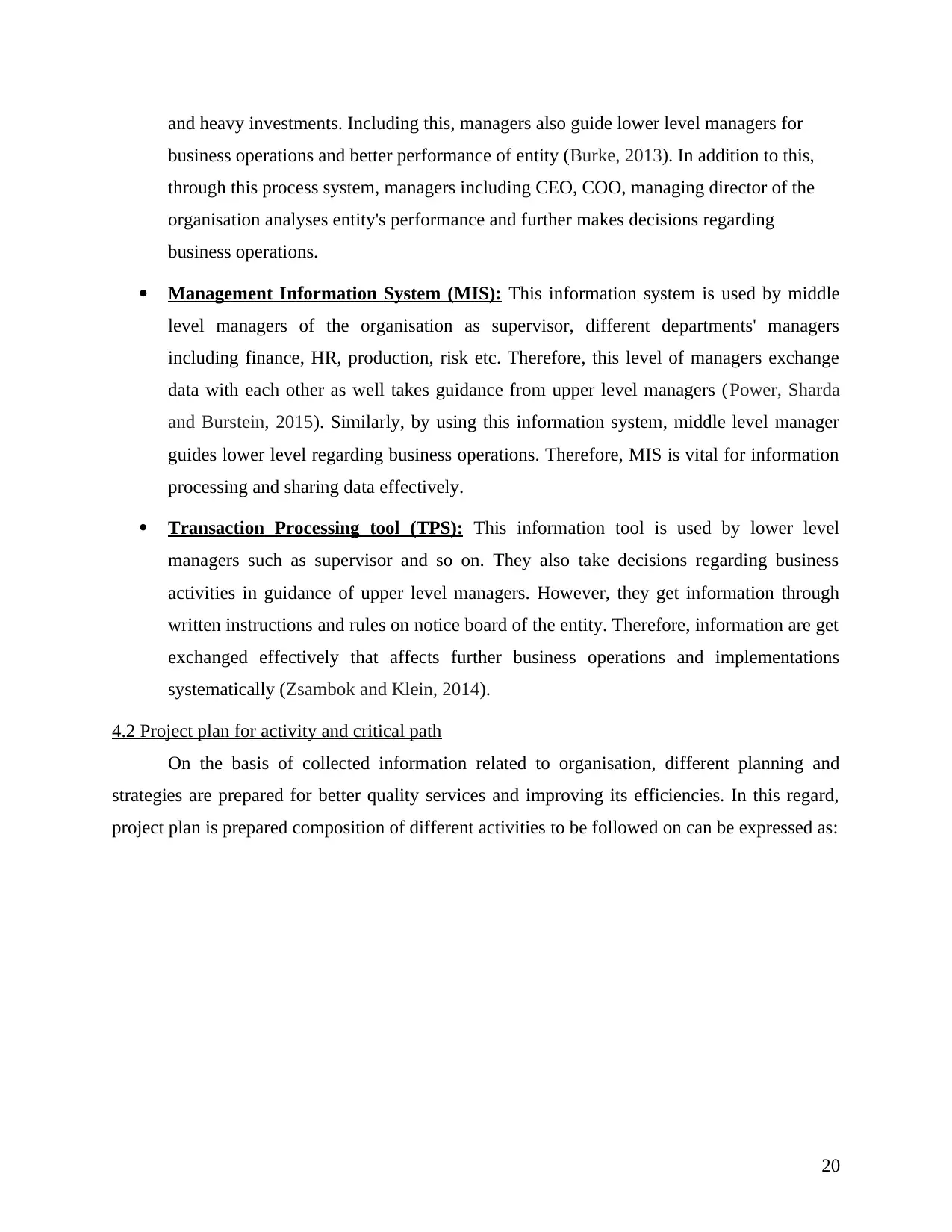
and heavy investments. Including this, managers also guide lower level managers for
business operations and better performance of entity (Burke, 2013). In addition to this,
through this process system, managers including CEO, COO, managing director of the
organisation analyses entity's performance and further makes decisions regarding
business operations.
Management Information System (MIS): This information system is used by middle
level managers of the organisation as supervisor, different departments' managers
including finance, HR, production, risk etc. Therefore, this level of managers exchange
data with each other as well takes guidance from upper level managers (Power, Sharda
and Burstein, 2015). Similarly, by using this information system, middle level manager
guides lower level regarding business operations. Therefore, MIS is vital for information
processing and sharing data effectively.
Transaction Processing tool (TPS): This information tool is used by lower level
managers such as supervisor and so on. They also take decisions regarding business
activities in guidance of upper level managers. However, they get information through
written instructions and rules on notice board of the entity. Therefore, information are get
exchanged effectively that affects further business operations and implementations
systematically (Zsambok and Klein, 2014).
4.2 Project plan for activity and critical path
On the basis of collected information related to organisation, different planning and
strategies are prepared for better quality services and improving its efficiencies. In this regard,
project plan is prepared composition of different activities to be followed on can be expressed as:
20
business operations and better performance of entity (Burke, 2013). In addition to this,
through this process system, managers including CEO, COO, managing director of the
organisation analyses entity's performance and further makes decisions regarding
business operations.
Management Information System (MIS): This information system is used by middle
level managers of the organisation as supervisor, different departments' managers
including finance, HR, production, risk etc. Therefore, this level of managers exchange
data with each other as well takes guidance from upper level managers (Power, Sharda
and Burstein, 2015). Similarly, by using this information system, middle level manager
guides lower level regarding business operations. Therefore, MIS is vital for information
processing and sharing data effectively.
Transaction Processing tool (TPS): This information tool is used by lower level
managers such as supervisor and so on. They also take decisions regarding business
activities in guidance of upper level managers. However, they get information through
written instructions and rules on notice board of the entity. Therefore, information are get
exchanged effectively that affects further business operations and implementations
systematically (Zsambok and Klein, 2014).
4.2 Project plan for activity and critical path
On the basis of collected information related to organisation, different planning and
strategies are prepared for better quality services and improving its efficiencies. In this regard,
project plan is prepared composition of different activities to be followed on can be expressed as:
20
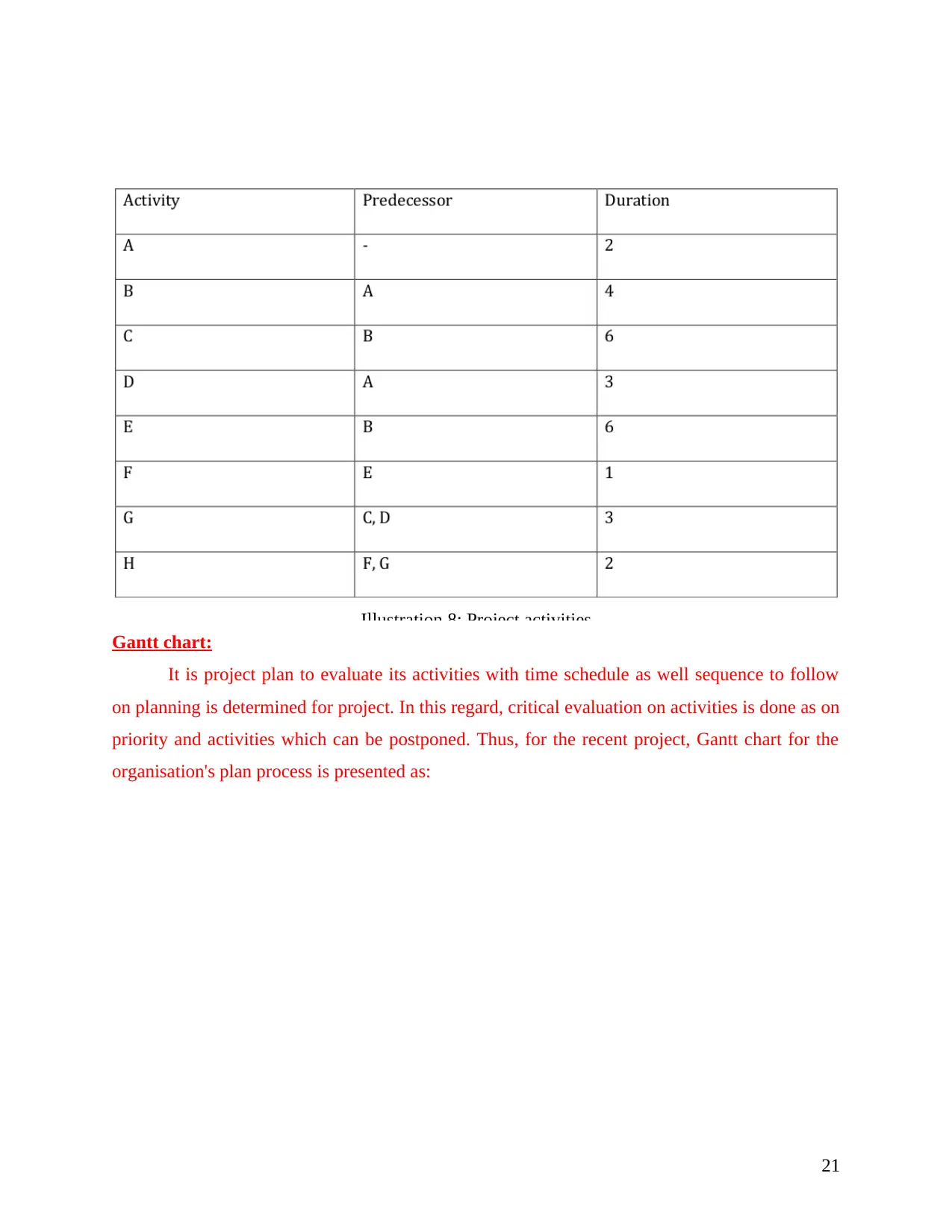
Gantt chart:
It is project plan to evaluate its activities with time schedule as well sequence to follow
on planning is determined for project. In this regard, critical evaluation on activities is done as on
priority and activities which can be postponed. Thus, for the recent project, Gantt chart for the
organisation's plan process is presented as:
21
Illustration 8: Project activities
It is project plan to evaluate its activities with time schedule as well sequence to follow
on planning is determined for project. In this regard, critical evaluation on activities is done as on
priority and activities which can be postponed. Thus, for the recent project, Gantt chart for the
organisation's plan process is presented as:
21
Illustration 8: Project activities
Paraphrase This Document
Need a fresh take? Get an instant paraphrase of this document with our AI Paraphraser
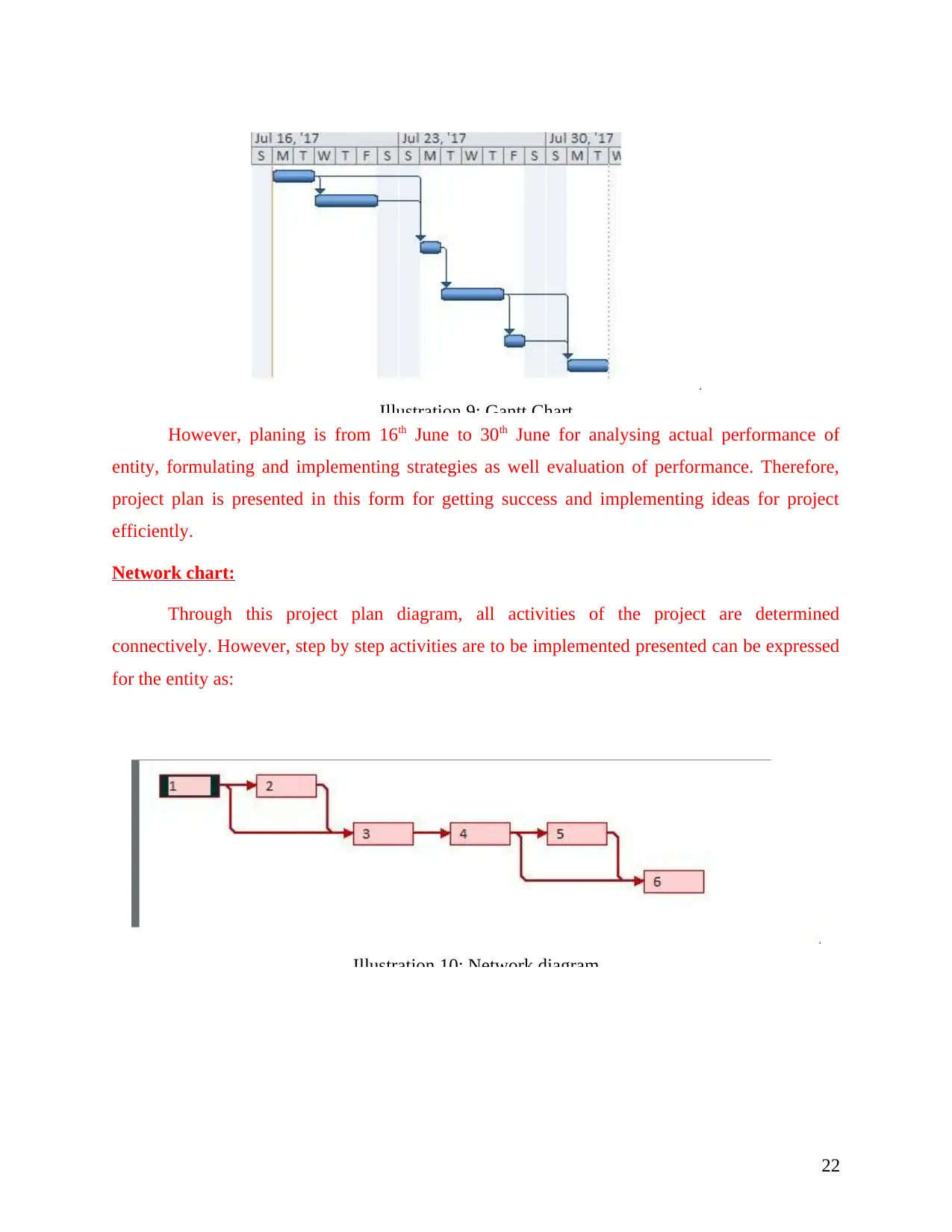
However, planing is from 16th June to 30th June for analysing actual performance of
entity, formulating and implementing strategies as well evaluation of performance. Therefore,
project plan is presented in this form for getting success and implementing ideas for project
efficiently.
Network chart:
Through this project plan diagram, all activities of the project are determined
connectively. However, step by step activities are to be implemented presented can be expressed
for the entity as:
22
Illustration 9: Gantt Chart
Illustration 10: Network diagram
entity, formulating and implementing strategies as well evaluation of performance. Therefore,
project plan is presented in this form for getting success and implementing ideas for project
efficiently.
Network chart:
Through this project plan diagram, all activities of the project are determined
connectively. However, step by step activities are to be implemented presented can be expressed
for the entity as:
22
Illustration 9: Gantt Chart
Illustration 10: Network diagram
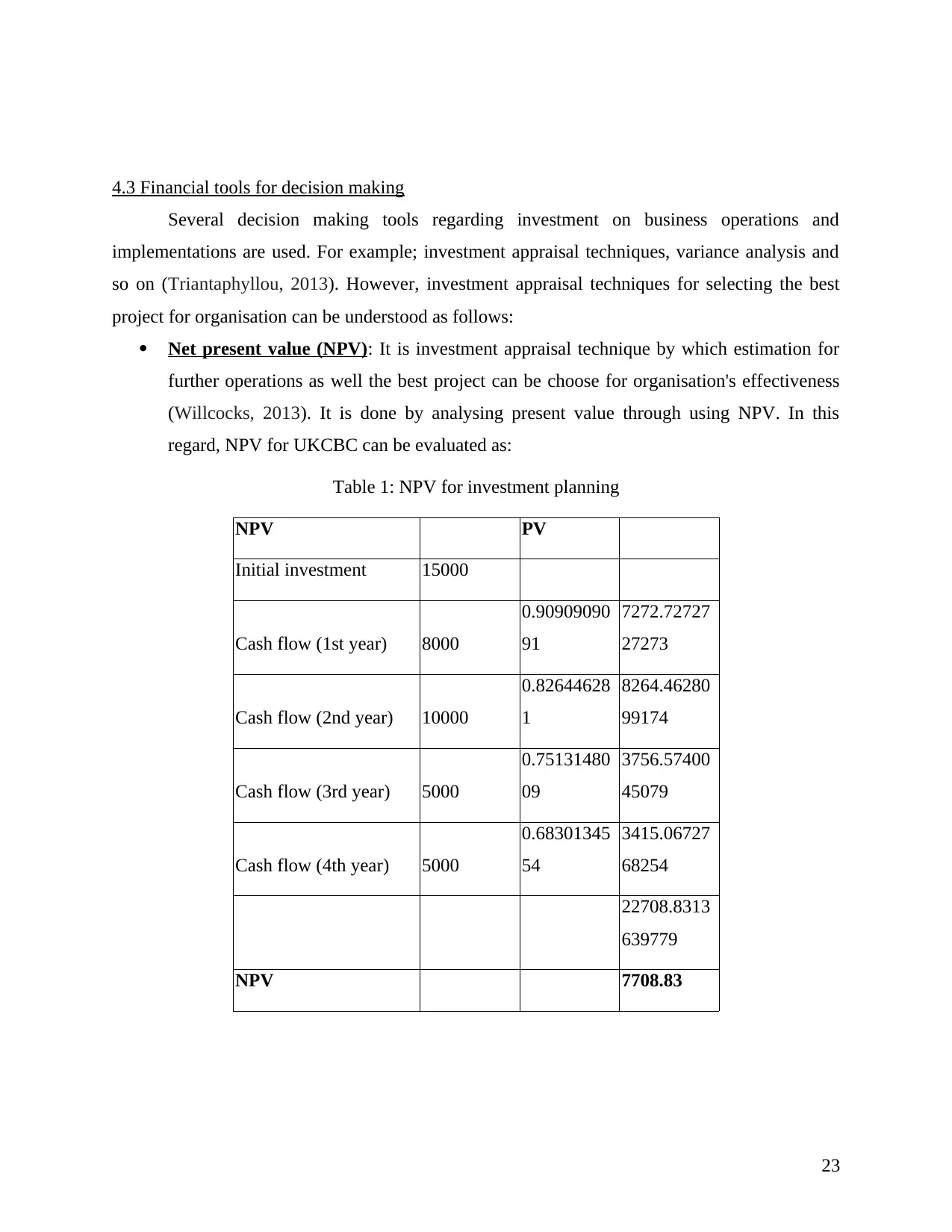
4.3 Financial tools for decision making
Several decision making tools regarding investment on business operations and
implementations are used. For example; investment appraisal techniques, variance analysis and
so on (Triantaphyllou, 2013). However, investment appraisal techniques for selecting the best
project for organisation can be understood as follows:
Net present value (NPV): It is investment appraisal technique by which estimation for
further operations as well the best project can be choose for organisation's effectiveness
(Willcocks, 2013). It is done by analysing present value through using NPV. In this
regard, NPV for UKCBC can be evaluated as:
Table 1: NPV for investment planning
NPV PV
Initial investment 15000
Cash flow (1st year) 8000
0.90909090
91
7272.72727
27273
Cash flow (2nd year) 10000
0.82644628
1
8264.46280
99174
Cash flow (3rd year) 5000
0.75131480
09
3756.57400
45079
Cash flow (4th year) 5000
0.68301345
54
3415.06727
68254
22708.8313
639779
NPV 7708.83
23
Several decision making tools regarding investment on business operations and
implementations are used. For example; investment appraisal techniques, variance analysis and
so on (Triantaphyllou, 2013). However, investment appraisal techniques for selecting the best
project for organisation can be understood as follows:
Net present value (NPV): It is investment appraisal technique by which estimation for
further operations as well the best project can be choose for organisation's effectiveness
(Willcocks, 2013). It is done by analysing present value through using NPV. In this
regard, NPV for UKCBC can be evaluated as:
Table 1: NPV for investment planning
NPV PV
Initial investment 15000
Cash flow (1st year) 8000
0.90909090
91
7272.72727
27273
Cash flow (2nd year) 10000
0.82644628
1
8264.46280
99174
Cash flow (3rd year) 5000
0.75131480
09
3756.57400
45079
Cash flow (4th year) 5000
0.68301345
54
3415.06727
68254
22708.8313
639779
NPV 7708.83
23
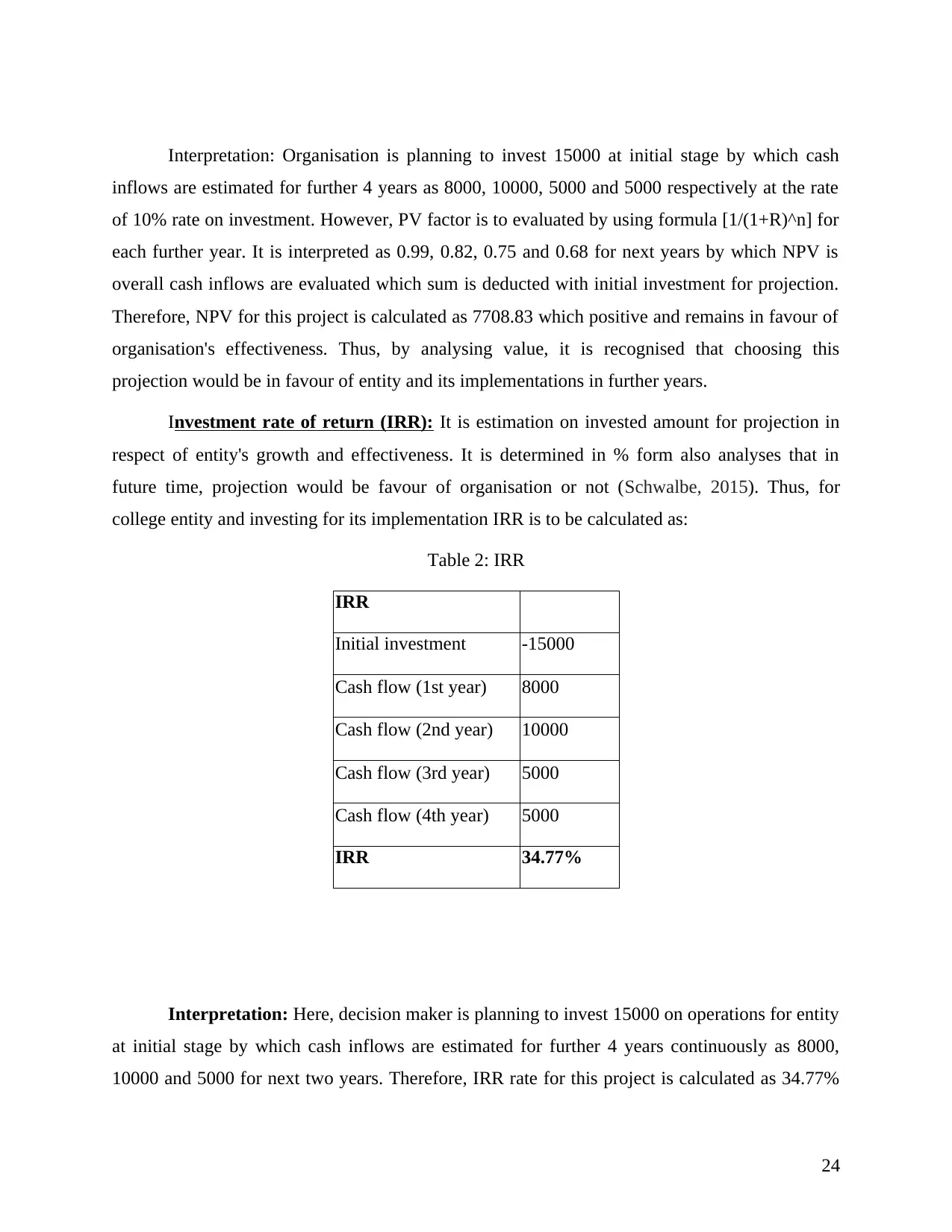
Interpretation: Organisation is planning to invest 15000 at initial stage by which cash
inflows are estimated for further 4 years as 8000, 10000, 5000 and 5000 respectively at the rate
of 10% rate on investment. However, PV factor is to evaluated by using formula [1/(1+R)^n] for
each further year. It is interpreted as 0.99, 0.82, 0.75 and 0.68 for next years by which NPV is
overall cash inflows are evaluated which sum is deducted with initial investment for projection.
Therefore, NPV for this project is calculated as 7708.83 which positive and remains in favour of
organisation's effectiveness. Thus, by analysing value, it is recognised that choosing this
projection would be in favour of entity and its implementations in further years.
Investment rate of return (IRR): It is estimation on invested amount for projection in
respect of entity's growth and effectiveness. It is determined in % form also analyses that in
future time, projection would be favour of organisation or not (Schwalbe, 2015). Thus, for
college entity and investing for its implementation IRR is to be calculated as:
Table 2: IRR
IRR
Initial investment -15000
Cash flow (1st year) 8000
Cash flow (2nd year) 10000
Cash flow (3rd year) 5000
Cash flow (4th year) 5000
IRR 34.77%
Interpretation: Here, decision maker is planning to invest 15000 on operations for entity
at initial stage by which cash inflows are estimated for further 4 years continuously as 8000,
10000 and 5000 for next two years. Therefore, IRR rate for this project is calculated as 34.77%
24
inflows are estimated for further 4 years as 8000, 10000, 5000 and 5000 respectively at the rate
of 10% rate on investment. However, PV factor is to evaluated by using formula [1/(1+R)^n] for
each further year. It is interpreted as 0.99, 0.82, 0.75 and 0.68 for next years by which NPV is
overall cash inflows are evaluated which sum is deducted with initial investment for projection.
Therefore, NPV for this project is calculated as 7708.83 which positive and remains in favour of
organisation's effectiveness. Thus, by analysing value, it is recognised that choosing this
projection would be in favour of entity and its implementations in further years.
Investment rate of return (IRR): It is estimation on invested amount for projection in
respect of entity's growth and effectiveness. It is determined in % form also analyses that in
future time, projection would be favour of organisation or not (Schwalbe, 2015). Thus, for
college entity and investing for its implementation IRR is to be calculated as:
Table 2: IRR
IRR
Initial investment -15000
Cash flow (1st year) 8000
Cash flow (2nd year) 10000
Cash flow (3rd year) 5000
Cash flow (4th year) 5000
IRR 34.77%
Interpretation: Here, decision maker is planning to invest 15000 on operations for entity
at initial stage by which cash inflows are estimated for further 4 years continuously as 8000,
10000 and 5000 for next two years. Therefore, IRR rate for this project is calculated as 34.77%
24
Secure Best Marks with AI Grader
Need help grading? Try our AI Grader for instant feedback on your assignments.
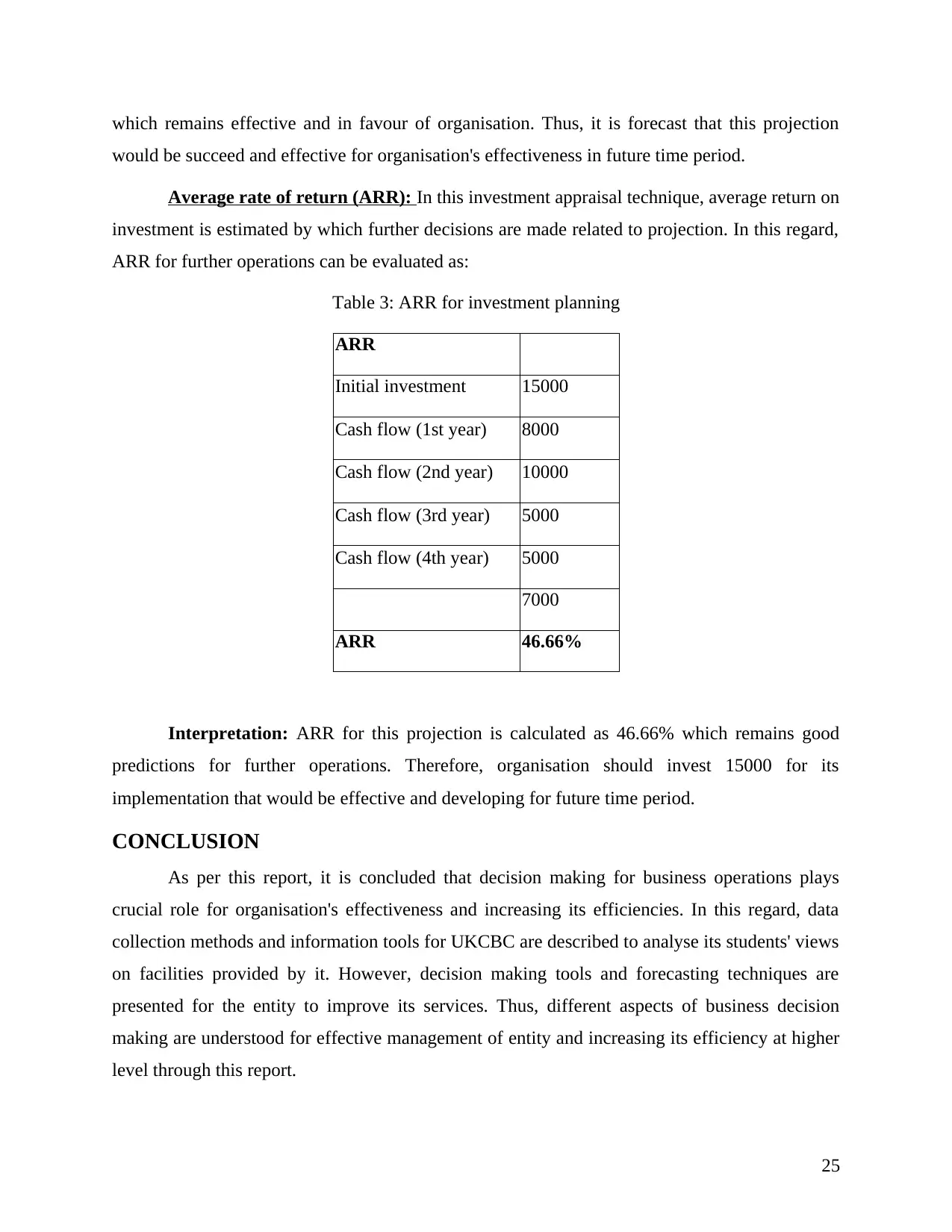
which remains effective and in favour of organisation. Thus, it is forecast that this projection
would be succeed and effective for organisation's effectiveness in future time period.
Average rate of return (ARR): In this investment appraisal technique, average return on
investment is estimated by which further decisions are made related to projection. In this regard,
ARR for further operations can be evaluated as:
Table 3: ARR for investment planning
ARR
Initial investment 15000
Cash flow (1st year) 8000
Cash flow (2nd year) 10000
Cash flow (3rd year) 5000
Cash flow (4th year) 5000
7000
ARR 46.66%
Interpretation: ARR for this projection is calculated as 46.66% which remains good
predictions for further operations. Therefore, organisation should invest 15000 for its
implementation that would be effective and developing for future time period.
CONCLUSION
As per this report, it is concluded that decision making for business operations plays
crucial role for organisation's effectiveness and increasing its efficiencies. In this regard, data
collection methods and information tools for UKCBC are described to analyse its students' views
on facilities provided by it. However, decision making tools and forecasting techniques are
presented for the entity to improve its services. Thus, different aspects of business decision
making are understood for effective management of entity and increasing its efficiency at higher
level through this report.
25
would be succeed and effective for organisation's effectiveness in future time period.
Average rate of return (ARR): In this investment appraisal technique, average return on
investment is estimated by which further decisions are made related to projection. In this regard,
ARR for further operations can be evaluated as:
Table 3: ARR for investment planning
ARR
Initial investment 15000
Cash flow (1st year) 8000
Cash flow (2nd year) 10000
Cash flow (3rd year) 5000
Cash flow (4th year) 5000
7000
ARR 46.66%
Interpretation: ARR for this projection is calculated as 46.66% which remains good
predictions for further operations. Therefore, organisation should invest 15000 for its
implementation that would be effective and developing for future time period.
CONCLUSION
As per this report, it is concluded that decision making for business operations plays
crucial role for organisation's effectiveness and increasing its efficiencies. In this regard, data
collection methods and information tools for UKCBC are described to analyse its students' views
on facilities provided by it. However, decision making tools and forecasting techniques are
presented for the entity to improve its services. Thus, different aspects of business decision
making are understood for effective management of entity and increasing its efficiency at higher
level through this report.
25
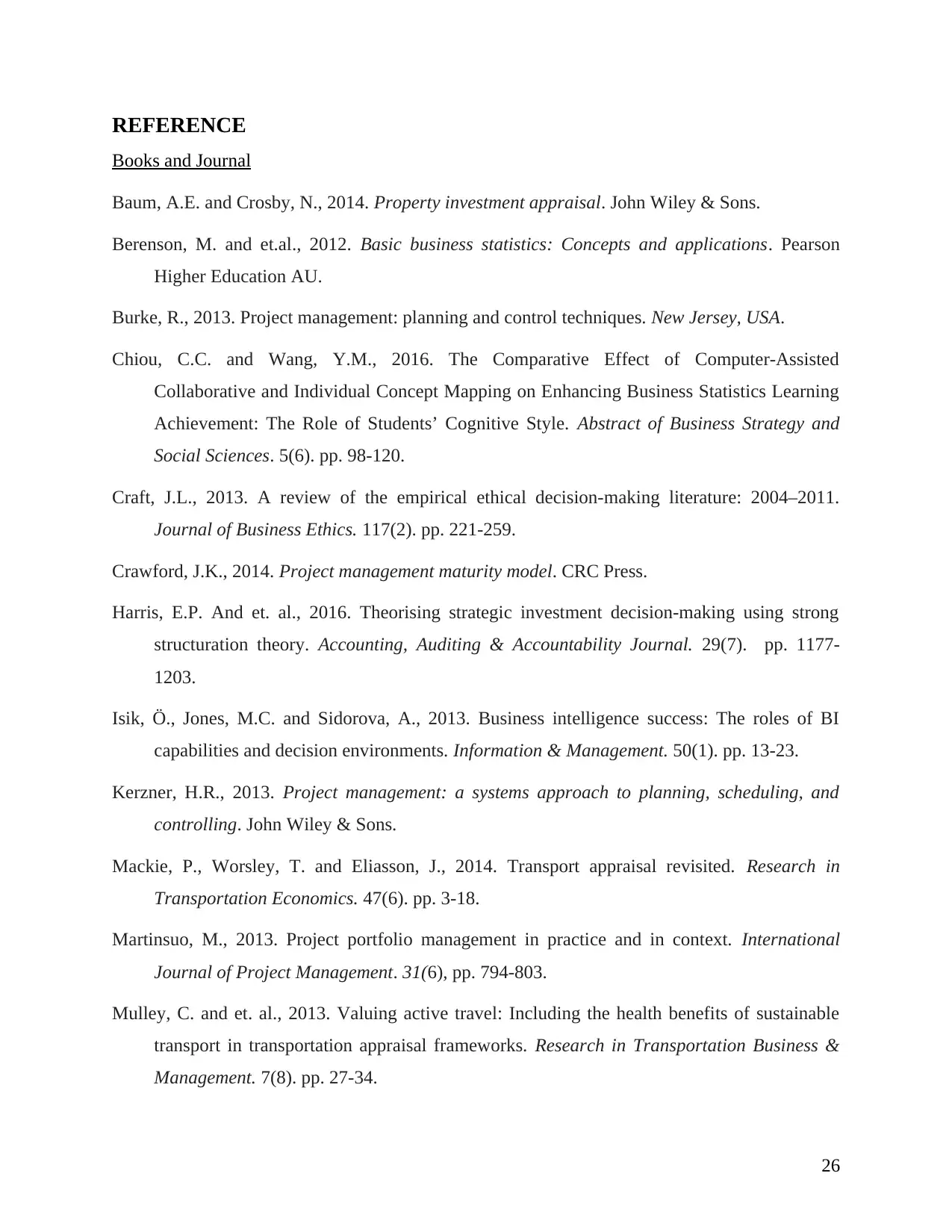
REFERENCE
Books and Journal
Baum, A.E. and Crosby, N., 2014. Property investment appraisal. John Wiley & Sons.
Berenson, M. and et.al., 2012. Basic business statistics: Concepts and applications. Pearson
Higher Education AU.
Burke, R., 2013. Project management: planning and control techniques. New Jersey, USA.
Chiou, C.C. and Wang, Y.M., 2016. The Comparative Effect of Computer-Assisted
Collaborative and Individual Concept Mapping on Enhancing Business Statistics Learning
Achievement: The Role of Students’ Cognitive Style. Abstract of Business Strategy and
Social Sciences. 5(6). pp. 98-120.
Craft, J.L., 2013. A review of the empirical ethical decision-making literature: 2004–2011.
Journal of Business Ethics. 117(2). pp. 221-259.
Crawford, J.K., 2014. Project management maturity model. CRC Press.
Harris, E.P. And et. al., 2016. Theorising strategic investment decision-making using strong
structuration theory. Accounting, Auditing & Accountability Journal. 29(7). pp. 1177-
1203.
Isik, Ö., Jones, M.C. and Sidorova, A., 2013. Business intelligence success: The roles of BI
capabilities and decision environments. Information & Management. 50(1). pp. 13-23.
Kerzner, H.R., 2013. Project management: a systems approach to planning, scheduling, and
controlling. John Wiley & Sons.
Mackie, P., Worsley, T. and Eliasson, J., 2014. Transport appraisal revisited. Research in
Transportation Economics. 47(6). pp. 3-18.
Martinsuo, M., 2013. Project portfolio management in practice and in context. International
Journal of Project Management. 31(6), pp. 794-803.
Mulley, C. and et. al., 2013. Valuing active travel: Including the health benefits of sustainable
transport in transportation appraisal frameworks. Research in Transportation Business &
Management. 7(8). pp. 27-34.
26
Books and Journal
Baum, A.E. and Crosby, N., 2014. Property investment appraisal. John Wiley & Sons.
Berenson, M. and et.al., 2012. Basic business statistics: Concepts and applications. Pearson
Higher Education AU.
Burke, R., 2013. Project management: planning and control techniques. New Jersey, USA.
Chiou, C.C. and Wang, Y.M., 2016. The Comparative Effect of Computer-Assisted
Collaborative and Individual Concept Mapping on Enhancing Business Statistics Learning
Achievement: The Role of Students’ Cognitive Style. Abstract of Business Strategy and
Social Sciences. 5(6). pp. 98-120.
Craft, J.L., 2013. A review of the empirical ethical decision-making literature: 2004–2011.
Journal of Business Ethics. 117(2). pp. 221-259.
Crawford, J.K., 2014. Project management maturity model. CRC Press.
Harris, E.P. And et. al., 2016. Theorising strategic investment decision-making using strong
structuration theory. Accounting, Auditing & Accountability Journal. 29(7). pp. 1177-
1203.
Isik, Ö., Jones, M.C. and Sidorova, A., 2013. Business intelligence success: The roles of BI
capabilities and decision environments. Information & Management. 50(1). pp. 13-23.
Kerzner, H.R., 2013. Project management: a systems approach to planning, scheduling, and
controlling. John Wiley & Sons.
Mackie, P., Worsley, T. and Eliasson, J., 2014. Transport appraisal revisited. Research in
Transportation Economics. 47(6). pp. 3-18.
Martinsuo, M., 2013. Project portfolio management in practice and in context. International
Journal of Project Management. 31(6), pp. 794-803.
Mulley, C. and et. al., 2013. Valuing active travel: Including the health benefits of sustainable
transport in transportation appraisal frameworks. Research in Transportation Business &
Management. 7(8). pp. 27-34.
26
1 out of 30
Related Documents
Your All-in-One AI-Powered Toolkit for Academic Success.
+13062052269
info@desklib.com
Available 24*7 on WhatsApp / Email
![[object Object]](/_next/static/media/star-bottom.7253800d.svg)
Unlock your academic potential
© 2024 | Zucol Services PVT LTD | All rights reserved.





